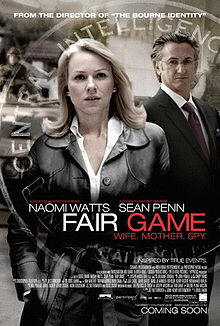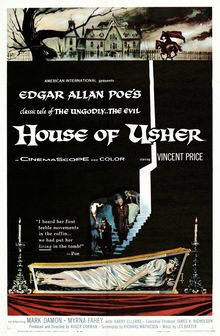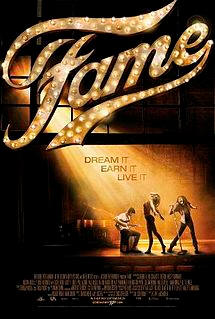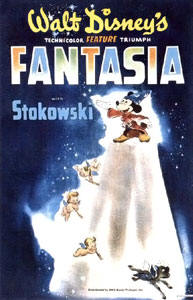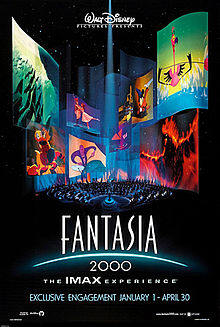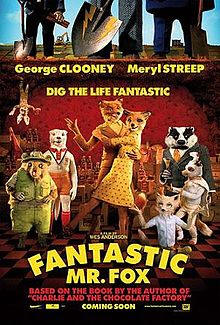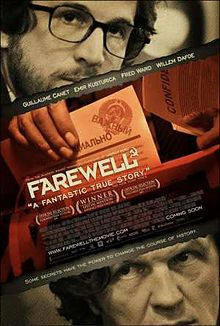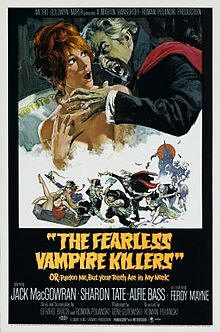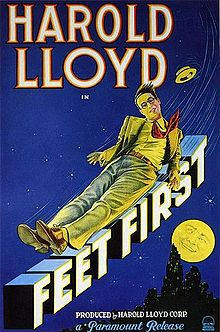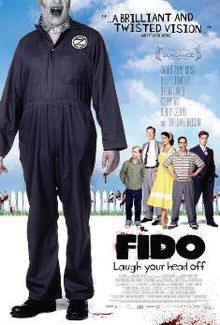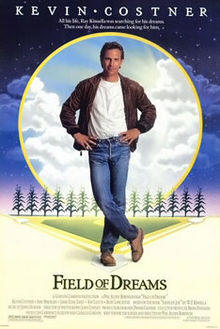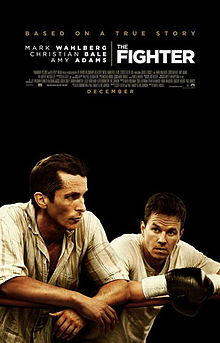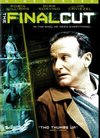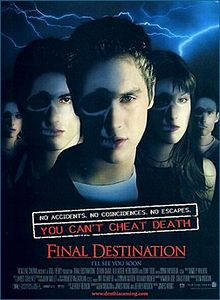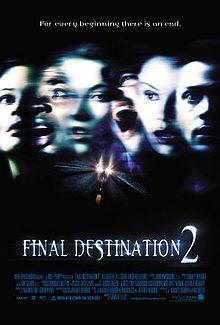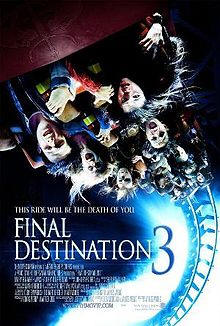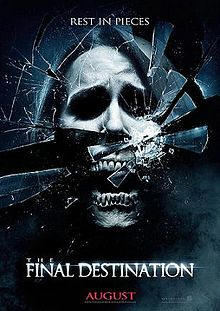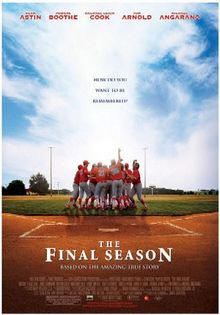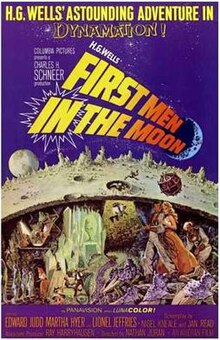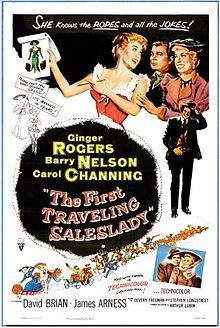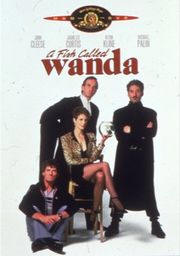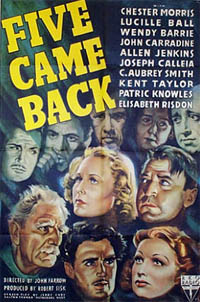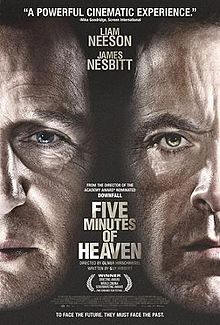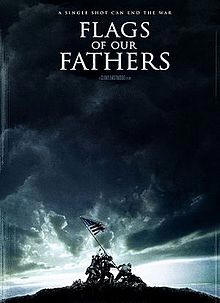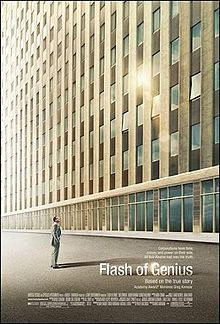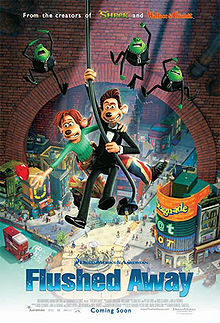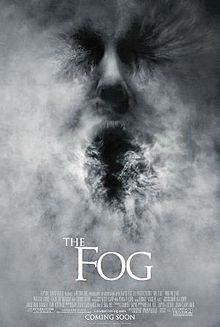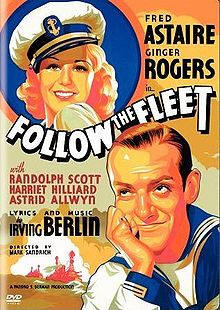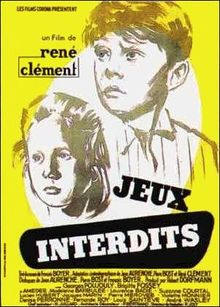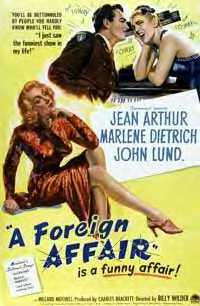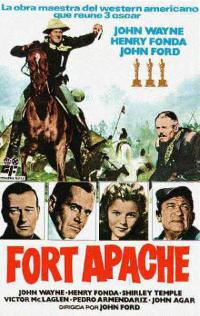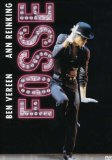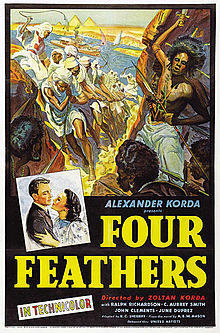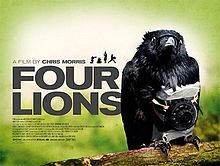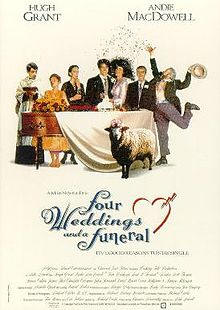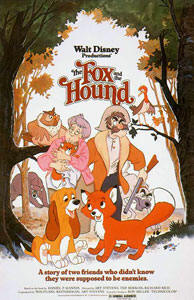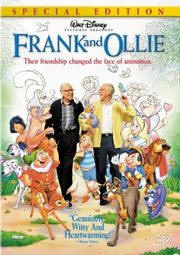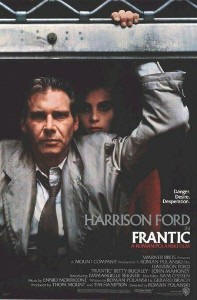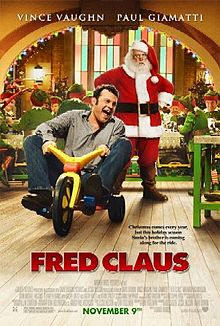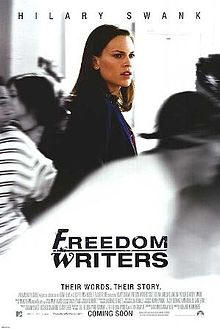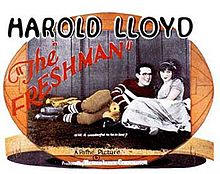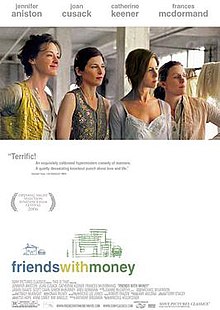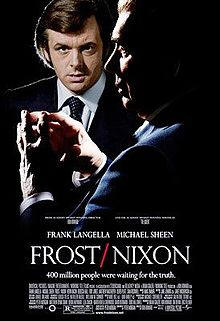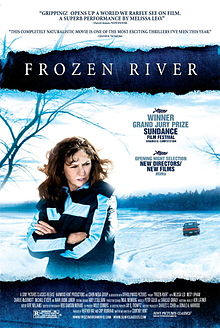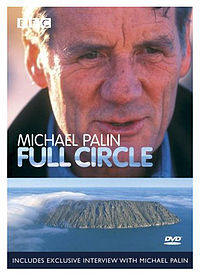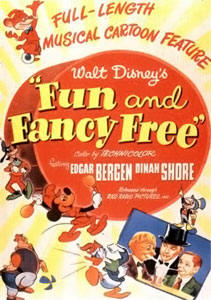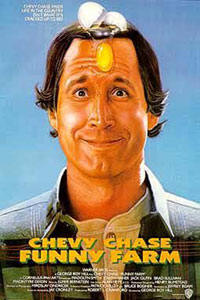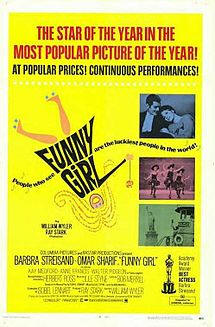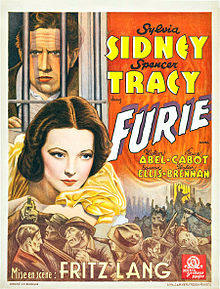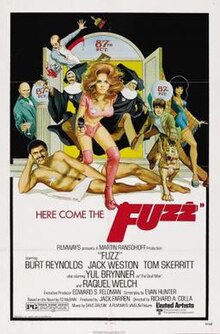|
Movies we've seen © 2004-2013 by John Varley; all rights reserved |
F
|
Facing Windows (La finestra di fronte) (Italian, 2003) An outwardly appealing movie that suffers from a lack of focus. A couple in Rome find an old man wandering, amnesic, and take him home. He gradually becomes part of the family. He revives some old dreams the wife has. Meantime, a weird romance blossoms with the man across the street, who is obsessed with the wife. The old man is a Holocaust survivor ... and it never really comes together. IMDb.com Fahrenheit 9/11 (2004) For years Lee and I have been devoted fans of documentaries. People don’t make them to get rich, they are almost always a labor of love. But they sneak into art theaters and play for about a week, often in December to quality for the Oscars. Then they’re gone. So you may not have heard of this film, but it’s worth your time. It’s made by an obscure filmmaker from Flint, Michigan, of all places, named Michael Moore. Apparently Mr. Moore doesn’t like George W Bush too much ... Okay, enough of that. You cannot review F9/11 without revealing your own political positions. You can say a few things about it as art, such as that the recreation of 9/11 in a dark theater with a black screen and surround sound is one of the most moving moments I have ever had in a theater. I wept. You can take him to task for his customary cheap shots. There are some here, not as many as usual. You can argue his facts. You can argue his slant. (My biggest What the fuck? moment was when he said Iraq was a nation that had never killed an American citizen. Tell it to the mothers of Desert Storm dead, Mike. That was a righteous war against an aggressor nation, supported by the whole world.) Bottom line, I can’t imagine coming out of the theater feeling anything but angry.
Well, I’m angry. And make no mistake, it’s Bush and his thugs I’m angry at. How angry? This being just a movie review, I won’t put my anger here. But if you want to know, go to "By Any Means Necessary" at this website. IMDb.com Fair Game (2010) Based on the true story of Valerie Plame vs. the scum of the GW Bush administration, including “Scooter” Libby (convicted, sentenced, and then commuted by scum Bush) and Dick Cheney, who deliberately outed her for blatantly political reasons concerning the lies they all told in the lead-up to the never-ending Iraq War. I didn’t follow the story all that closely at the time and so can’t vouch for its absolute accuracy, but if even a tenth of the things we see are true a lot more people should have gone to prison than ol’ Scooter, including Cheney and Bush. So sad that they will never be prosecuted. As a movie, it’s really only so-so, but Naomi Watts is always good, and she shines here. IMDb.com The Fall of the House of Usher (1960) I almost certainly saw this in the ‘60s at a dawn to dusk show at the Don Drive-in in Port Arthur, Texas—where me and a couple other guys would sit through 4 or 5 movies with themes like “Beach Party” or “Edgar Allan Poe”—but I didn’t recall a thing about it. No wonder; it’s pretty forgettable. We watched it Halloween night on a channel that was running a Vincent Price Festival, called “The Price of Fear.” I never read the story, but I see they changed a lot while keeping the general themes of madness, obsession, premature burial, a living house, and general creepiness. Everybody hams it up, most of all that former Champeen Ham (until William Shatner came along), Vincent Price. It is lushly photographed in super-saturated Technicolor by Floyd Crosby, father of our friend David. Rather nice to look at, but pretty boring until it finally gets moving at about the one-hour point. IMDb.com The Fallen Idol (UK, 1948) Here’s a crackerjack little thriller of the understated kind the Brits do so well. Ralph Richardson is Baines, the butler at the London embassy of an un-named French colonial country. He has a terrible wife who he wants to leave, because he is in love with one of the secretaries there. One night there is an argument at the top of the stairs, and she falls to her death. Also at the embassy is young Phile (Philippe, but pronounced Phil), the son of the ambassador. He’s innocent, imaginative, and struggling with the concepts of truth and lies, and when a lie is permissible. He adores Baines, who is the only one who has any time for him. He’s also a snoop, like most children. He sees the argument, and then he hears the wife fall, and sees her body. We know what Phile doesn’t know, which is that Baines did not push her. She fell a moment later, while trying to get into the bedroom where Baines and his lover had been, and happened to hit where it looks like she fell down the stairs. But Phile believes Baines killed her, and is determined to lie to protect him. Meanwhile, Baines and his lover have also lied, to avoid bringing her into it all. Soon the lies start to contradict each other, stories keep changing, forensic evidence is pointing to murder. Jack Hawkins is a detective who soon is weaving a web of evidence that will trap Baines, who is hardly any better at lying than Phile is. Won’t tell you the ending, but I was very satisfied with it. Other than the dramatic fight, there isn’t a lot of action, but it’s great how the tension can mount over very small things. We know the truth, we know the cop is wrong, but it sure looks like Baines is a killer. It’s small things, and they add up until the last five minutes, as Phile is desperately trying to tell what he thinks is the truth, but will surely doom Baines. Sweet! Bernard Lee has a small part as a detective. You probably know him as the original M from the James Bond movies with Sean Connery. IMDb.com Fame (1980) (NEW REVIEW) This film moved me profoundly when I first saw it, when it was new. It got me from the first frames, seeing all these kids auditioning, and it kept getting better. I don’t know when it dawned on me that this was not a made-up place, this was a real school. The New York High School of Performing Arts really existed. (And still does, merged with another arts school and moved to a new location.) The idea of such a place, where students were trained to sing, dance, perform, and play music, was stunning to me. Not because I thought I could have gone there. My French horn playing would never have gotten me within the same zip code of this place, and my acting and dancing talents are non-existent. But I learned there were other specialized high school in NYC, and I know I could have made it there. I don’t want to put down my own alma mater, Nederland High School, too much, we were an okay school with a great band program, but it was a small town. When I arrived at NHS they had just started an “accelerated” science program, with “new math” and a plan for extra science courses. It was great … for two years. Then the only teacher qualified to teach second-year physics left, and me and about fifteen others were stranded. So in my senior I and two other guys taught first-year physics, overseen by a biology teacher who didn’t know a joule from a diamond ring. I was cheated, I was robbed, I was not prepared for college-level science. Well, them’s the breaks, I guess. So watching this film both delighted me, and filled me with envy. All my life I’ve wanted to live in the big city, New York most of all. This was all about big-city kids, kids with dreams. They were working, hard. It was a real tonic after all the stories you hear about how kids aren’t learning anything in school anymore. I’m sure that’s true of a lot of kids, but not these. As a film and a musical, it’s great. The director, Alan Parker, has been all over the map in his career, with stuff as bad as The Life of David Gale and as good as The Commitments, which is on my Top 26 of All Time list. (He also directed the very odd Bugsy Malone, which most people either love or hate.) Here he keeps everything perfect, following a half dozen kids through all four years. The music always flows from the situation, nobody interrupts the action to break out in song, as in a Broadway musical, and while it may be improbable that kids would run out into the streets and dance on the cars, or that a very creative jam session would spontaneously start in the cafeteria … these kids are so bursting with energy that it is believable, and lots of fun. As I watched these kids audition, I realized that all the actors playing the parts had gone through the same hell to get their parts. And as the teachers pointed out just how hard their chosen career was, and just how few make it … I wondered how many of these people would be household names in, say, 30 years. Answer: only Debbie Allen, who had a small part and then made it in the TV series which I never watched for the same reason I never watched “M*A*S*H,” and she’s not what you’d call a megastar. Of the kids, a few others have eked out careers in television, but none of them achieved FAME. Oh, well, them’s the breaks. IMDb.com Fame (2009) The reviews for this were just awful, which can help me like a picture if it turns out to be not quite as awful as everyone is saying. That’s the case here. It starts off with a lot going against it, as it will be compared with the original, and it’s not in the same league with that, not by a long shot. But it’s not a terrible movie. There are some moments of great energy and foot-tapping music and dancing. Where it falls short is in the characterizations of the individual students. They just don’t come alive for me the way Doris (Delores), Ralph, and Montgomery did in the original. And there’s no current equivalent of the Rocky Horror Picture Show scenes, like in the first one, and no teacher who comes alive as much as tough Mrs. Sherwood (Anne Meara) … well, I could go on and make it sound a lot worse than it was, but it wasn’t a waste of my time. IMDb.com The Family Stone (2005) This is one of those down the middle pictures. There are many things to like, and some that don't make a lot of sense. Mostly, it's the sort of picture actors love. Everybody is talented, and gets to show off here and there. Sarah Jessica Parker shows up for Christmas as the new girlfriend, almost fiancée, of the oldest boy in a large family. Diane Keaton detests her on sight, though she is polite. So does her youngest daughter. It is impossible for Parker to please this family, partly because she is just the wrong sort of person for them, and because she tried so hard she's guaranteed to fail, and in the end, because she's wrong for the guy. Complications ensue, some of them funny, some of them poignant. Soon we discover that SPOILER WARNING! Mom is dying of cancer, and I thought, oh boy, here we go again. But I have to say that part wasn't overplayed. The movie was more about love and finding the right person than about death. I guess I'd give it two stars, out of a possible four. Maybe two and a half. Must add that I am entranced by Rachel McAdams who, last year, sparkled in Wedding Crashers, and in Red Eye, out-did Jodie Foster's Flightplan for thrills and you-go-girl! spunk. Which is really saying something, because Foster's movie was damn good. IMDb.com Fantasia (1940) Saturday Night at the Toons! IMDb.com Fantasia 2000 (1999) Saturday Night at the Toons! IMDb.com Fantastic Four (2005) I’ve said elsewhere that I was never a comix reader. A friend of mine was, and I sometimes browsed his collection. I’m not sure why, but The Fantastic Four was the one I found most interesting. I can’t really say why, except that Ben Grimm’s wry and funny observations made me chuckle. This film did, too, several times (Silly Putty Man falls asleep with his face in the computer keyboard, and wakes up with one side of his face looking like a waffle iron), and the intervening action was pretty groovy. The makers of this film have set out to do no more than capture the spirit of the comic, and succeeded pretty well. The premise is bullshit, but the premise of all superhero comics is bullshit. Who cares that “Our DNA structure was altered by the cosmic storm!” or “I was bit by a radioactive spider!”? This dude can stretch, this one can set himself on fire, this one looks like a first-grader’s sculpture in orange modeling clay, and the girl can turn invisible. Accept it, and move on. How would people react to this stuff? The Torch digs it; the Thing (the name sort of says it) thinks it sucks. How would you react? Like Catwoman and the Torch, I think it’d be cool (if I wasn’t ugly like Ben Grimm). No Spiderman angst for me, thank you very much. Flame on! IMDb.com Fantastic Mr. Fox (2009) Everyone once in a while I just don’t get it. A movie comes along that is almost universally praised by critics and audiences alike, and it leaves me cold. I’m not so surprised when it’s something like Sin City. We live in an age when this sort of violent pornography is so standard that no one seems to notice anymore that it is morally bankrupt and, frankly, degenerate and disgusting. But here’s an animated picture—and I love animation—technically very well done, visually new … all in all, real nice to look at. And that’s all I did. Look at it. I never felt the least bit involved. Here’s these people with the heads of foxes and other wild animals, dressed in suits and dresses. So what? Just didn’t work for me. And don’t tell me it’s because the movie is slightly weird, showing people with the heads of animals. I like weird. I loved The Triplets of Belleville, and Ponyo. It was nominated for the Best Animated Feature Oscar. It if had beaten Up, I would have had to pelt the Academy with little furry puppets. IMDb.com The Far Country (1954) A movie noteworthy mostly for its fabulous vistas of the Yukon Territory during the gold rush. It was actually filmed in Alberta, which I guess isn’t too far off. Everywhere you look, towering mountains, snow, glaciers. They even recreated the famous scene of the prospectors laboring up the Chilkoot Pass, which can be seen on a commemorative Alaska license plate. Other than that, I wasn’t too taken with it. This was the fourth western collaboration of Jimmy Stewart and Anthony Mann. Stewart is a cattleman bringing a herd up to the Yukon because the prices are great. They go by ship up to Skagway, where a corrupt Marshall takes them from him. He and crusty sidekick Walter Brennan go prospecting, but the venal snake-in-the-grass is taking over all the claims. You know it will end in blood, but Stewart takes way too long to do anything, because he has to see the error of his selfish ways and lose his friend first. I grew very impatient with him. And with the townspeople, who are all armed, all tough men, and all somehow cowed by the handful of nasties employed by the Marshall. Only at the very last moment do they show up and drive the skunks out of town, and I kept thinking, “Oh, so now that Jimmy is shot to pieces, now you show up with your rifles? Screw the lot of you. You don’t deserve to hold on to your claims if you won’t fight for them.” IMDb.com Far From Heaven (2002) The serious side of Down With Love. This also looks as if it were made in the ‘50s or ‘60s, and it concerns interracial love and homosexuality, and does a very good job of it. IMDb.com Far From the Madding Crowd (UK, 1967) “Madding” at this time meant “frenzied.” I’ve always wondered about that. This is one of those I missed when new, and I seem to be catching up on a lot of missed big movies lately. So be it. I enjoyed it, but more for the widescreen spectacle than for the story, which I found to be frequently frustrating. But I get that way when I see people making stupid choices, particularly beautiful women. (This was from the glory roadshow days, with an Overture and an Intermission. And considering how many movies are running three hours or more these days, how about reintroducing fifteen-minute intermissions?) Julie Christie is a headstrong young woman who inherits a farm in Dorset, in the west of England and decides to run it herself. Before this happens she is proposed to by Alan Bates, a shepherd. But she is not in love with him. He is ruined when one of his sheepdogs drives his herd over a cliff, and ends up working for her. Soon after, she flirts with a wealthy landowner, Peter Finch, who is also smitten, but she’s not in love with him, either. She treats him very badly. So who does she fall in love with? Why, the dashing young cad (Terence Stamp) in the dashing red uniform who enthralls her with a dashing phallic display of his sword. (No, a real sword.) He’s already fathered an illegitimate child. Any man alive, and any woman who has been around for a few years, knows instantly that he’s a bounder, but women stupidly go for that stuff, just as men stupidly go for a pretty face and a pair of boobs. I have always enjoyed seeing how things are done, and this one is full of farming and sheep-ranching lore. At one point her flock of mutton are all getting sick, staggering around, about to die. Bates is sent for, and he arrives with his trusty trocar, which he stabs into the sheep’s sides, releasing a great deal of gas. They have the bloat, which they get if they eat too much clover or other legumes, which is why you need to keep your sheep away from clover. I didn’t know that. It’s a fascinating scene. The cad marries her, but an old flame turns up, pregnant with his baby. She and the baby die, Julie finds out about it, and she still wants to stay with him, the little idiot. He tells her the dead girl means more to him than she ever will. And still … oh, it’s painful to see an otherwise strong and level-headed woman debase herself with a worthless bastard like him. He swims out into the ocean and is presumed drowned, but he soon turns up again, like a bad penny, in the circus of all places, playing the role of Dick Turpin. Worse, he shows up on the night of Finch’s engagement to Julie, and claims her as his wife. Finch goes bonkers, and shoots his worthless ass. He goes to the gallows, and Julie finally comes to her senses, realizes that Bates was always the one for her, they get married, the end. Sort of abrupt, and I didn’t like the story all that much. But it kept my interest in portraying a way of life that I couldn’t stand for a week, but had its attractions. I very much liked the circus scenes, and was taken once again with the idea that, in those times, you had to provide your own amusements except for special times when the circus came to town. So everyone sang, both solo and in groups. I find those scenes touching. These days, of course, you’d plug your mix on your iMac into a boom box and let others do the singing. IMDb.com Farewell (L'affaire Farewell) (France, 2009) In the age of Reagan, Mitterand, and just before Gorbachev, a Russian in the KGB is fed up with the Soviet Union and hopes to force a change by passing some very high-level data to the French. As his go-between he picks a French engineer in Moscow with no ties to any spy agency, and thus without a KGB dossier. It is “based on fact,” as they say, and this time they may not have jazzed it up too much. There aren’t any scenes of James Bond flamboyance; this is more how real spies work, with clandestine meetings, dead drops, and lots and lots of fear and paranoia. The tension mounts nicely, and there are good performances by all concerned, including Fred Ward as Reagan, who really looks very little like him but manages to seem to look like him, if that makes any sense. IMDb.com Fargo (1996) Reviewed in Coen Brothers. IMDb.com The Fast and the Furious: Tokyo Drift (2006) Second feature at the drive-in. IMDb.com Father of Invention (2010) Kevin Spacey is Robert Axle, a TV pitchman who has built a $1.6 billion-dollar company on the strength of his inventions, which are always the fusion of two products already on the market. We see his pitch at the beginning, showing several silly products. My favorite is a camera that also shoots pepper spray, so you can disable a mugger and take his picture at the same time. But one of his products has a propensity to pinch off people’s fingers … We rejoin him ten years later as he exits a prison after eight years on the inside. He is penniless, homeless, bedraggled, beaten down by life. His ex-wife, Virginia Madsen, has gotten $362 million dollars in a settlement, his classic gull-wing Mercedes, his palatial mansion … everything. His former business partner now has the company. He moves in with his daughter, Camilla Belle, and her two quirky roommates, Heather Graham (who was 40 when this was made, and looks 25!) and Rhoda Griffis. He has lots of issues with his daughter, who was emotionally neglected as a child. The wife has somehow managed to burn through every nickel of the third of a billion. “You’d be surprised how easy it is,” she says. One way: She wanted a gold record, though she has no talent. So she has 300,000 copies of her album printed, and buys 298,000 of them herself. Somewhere in New Orleans, where this was filmed, there is a warehouse full of bad music. Poor Kevin is rebuffed at every turn. He keep encountering people with missing fingers who remember all too well who he is. He is unable to keep a job or get a loan for his new, fabulous idea—a combination wireless child “leash” and video game—and his old partner is going to steal it from him. So I’ve mentioned some of the good stuff. Practically all of it, come to think of it. It’s very predictable. With twenty minutes to go we decided we were just interested enough to see how it all came out. And you can guess, and you’d be right. He has his come-to-Jesus moment onstage, in front of a thousand potential investors, saying this crap isn’t important, it’s your family that’s important. To huge applause. Yeah, right. Father and daughter reconcile, and even the bitch ex-wife turns out to be a honey pie. Yuck. IMDb.com The Fearless Vampire Killers (1967) This is the film Roman Polanski made before his huge hit Rosemary’s Baby. It didn’t fare so well, mostly because MGM had no idea what to do with it. When I first saw it, they had given it the awful title The Fearless Vampire Killers, or Pardon Me, But Your Teeth Are in My Neck. This was totally at odds with what kind of film it is, which is certainly a comedy, but by no means a farce. Polanski didn’t want either title; it was originally Dance of the Vampires. Much better. Also, when I saw it new, they had pasted a really, really amateurish and stupid animated prologue that gave away virtually every joke in the movie. It was as if they were afraid that no one would be able to deal with the concepts of a Jewish vampire and a gay vampire without some advance warning. In spite of all that, I loved this movie, and I still do. It is meticulously crafted, with huge sets and wonderful costumes, and a feel for the cold heart of Transylvania, both the Count in his castle and the peasants in their mean little inn. Jock MacGowran is wonderful as Professor Abronsius, the slightly dotty old vampire hunter. Alfie Bass is great as the Jewish father who goes out to rescue his child (Sharon Tate, and how creepy is it to see her in a film all these years later?) and gets more than he bargained for. Polanski himself portrays the bumbling, terrified assistant. And last but not least, Ferdy Mayne as Count von Prolock is somehow very funny and at the same time much scarier than a hundred other vampire counts in a hundred other vampire movies that are actually trying to scare you. IMDb.com Feet First (1930) Harold Lloyd’s second “talkie,” one of only seven he made. He’s a shoe salesman in Honolulu who aspires to better things, and the story contains his usual physical humor combined with his attempts to squirm out of embarrassing social situations. It’s most noteworthy for an extended scene that looks even more perilous than his stunts in Safety Last!, which contains the famous image of him dangling from the hands of a clock, many stories above the street. This involves his misadventures all up and down the side of a skyscraper on a window-washer’s rope scaffold. Not for people with acrophobia. He is “helped” by a slow-moving, slow-talking, slow-witted black janitor, played by Willie Best, whose stage name early in his career was “Sleep ‘n’ Eat.” He was from the Stepin Fetchit school of acting … which, of course, was about the only roles open to blacks at the time. He was well-respected in the business, and tried to get the worst racism out of his movies, but what can you do? IMDb.com Fellini: I'm a Born Liar (Federico Fellini: Sono un gran bugiardo) (2002) Not long before he died Federico Fellini did a longish interview on film. About half of this movie is that interview. The rest is scenes from his films, intercut with present-day shots of the locations, scenes of him directing, and interviews with people who worked with him. It is by no means a biographical movie. Not much is said about his life or career. Instead, it is the creative process that is explored, and Fellini’s was unusual. He mentions several times that he doesn’t view actors as cattle, like Hitchcock, but rather as puppets. Both Donald Sutherland (Casanova) and Terence Stamp (Spirits of the Dead) tell us that this wasn’t always a lot of fun. Since Italian directors often don’t record sound on the set but prefer to overdub later, Fellini can stand by the camera and tell the actors exactly what he wants. You can almost see the strings. It is the antithesis of the Hitchcock method. Hitch never improvised, he had the whole movie, frame by frame, in his head before he even started shooting; he said he found the shooting itself boring. Fellini made it up as he went along, changed things he didn’t like, was much more concerned with the look of it all. Different strokes for different folks. So it’s an okay documentary, if a little long. A lot of what Federico says strikes me as impenetrable, but he did say one thing I identified with. “I’ve accepted an advance to make a film, and I don’t want to give it back, so I make a film.” The pressure of making a living is one of the great unsung causes of great art. Artists like to talk about their muses, their visions, the way the art is pushing to get out of them. It pushes a lot harder when there’s no money in your pocket, and I’ll bet even Michelangelo would have told you that. IMDb.com Fever Pitch (2005) This was the first feature at the drive in; the second was The Pacifier. What we got was a film-school double feature: How to write comedy, and how not to write comedy. The only reason I can see why anyone would not love this movie is that they absolutely hate baseball. Sort of the way Lee reacted to Million-Dollar Baby. That’s cool, but if you like baseball even a little, this is one of the best romantic comedies we’ve seen in a while. If you love baseball, as we do, and if you love the Boston Red Sox and the Chicago Cubs, the only teams left in the game who play it the way it should be played, you’ll like it even more. I’ve only been to Boston once in my life, spent only a few hours there, but I’m a Sox fan. You just have to love such a loser. Not that they’ve been awful in recent years, it’s the horrible way they have come so close, so many times, only to blow it in the final stretch. This movie had to undergo some rewrites at the last minute because ... well, it was about a man who had given his life to rooting for the Sox, and it was happening in the 2004 season, so how are you going to end it? You have to end it with him being disappointed yet again, probably in the bottom half of the ninth, to the stinking Yankees. I mean who knew? You simply could not have written that the Sox would come back from three games down to the horrible Yankees in the playoffs ... AND COME BACK TO WIN 4 IN A ROW! The biggest comeback (Sox) and the worst choke (goddam Yankees) in the history of baseball! If it had just been about that, Fever Pitch would have been fun. But it’s a lot more. Jimmy Fallon is a lifelong Sox fanatic. His life revolves around the team, from spring training to the inevitable collapse in September. He falls in love with Drew Barrymore, who doesn’t even know what a foul ball is. An accommodation is reached, then troubles ensue, then true love finds a way. Standard stuff, but the way you make it work is with clever dialogue, good comic situations and, what so many directors and writers neglect, well-written and acted secondary characters. Fallon’s Red Sox “family,” the people around him in his season-ticket seats, are fun, and Drew’s friends are fun, and it all works just gloriously. We just about died laughing when Fallon, depressed about the failure of his relationship, is discovered by his friends, hollow-eyed, unshaven, endlessly rewinding and watching the worst moment in Red Sox history: Bill Buckner letting an easy grounder to first bounce between his legs in a game that should have clinched a World Series win. It’s crisis intervention time! One guy brandishes the videotape and shouts “You got any more of these? Where’s your stash?” Hilarious! IMDb.com Festival Express (2003) This film is like opening King Tut’s tomb. Talk about ancient history. In 1970, or 4000 BC, take your pick, a couple young promoters organized a train trip across Canada with some popular rockers of the time. We’re talking The Band, The Grateful Dead, Janis Joplin, The Flying Burrito Brothers, Ian & Sylvia, and others. They were immediately besieged by a lot of baby anarchists who were enchanted with the idea that “the music should be free,” that “it belongs to the people.” Sound familiar? It’s exactly what illegal downloaders say to justify their thefts. Hey, Woodstock was free, right? Anyway, the project ran out of money very soon, but the promoters kept it going, even making a special stop in Alberta to get more liquor when the musicians drank the train dry. But when it was all over, they didn’t have the money to make the film they had intended, so a whole lot of footage sat in obscure vaults for 34 years. Now somebody has excavated it, blown off the dust of centuries, and made it into a 90-minute film, all of it never seen before. As a film, it is inferior to Monterrey Pop or Woodstock, there was a bit too much concentration on the crowds and the train tracks for my taste, though it was weird to think this all literally came out of a time capsule ... but that doesn’t mean you shouldn’t see it. If you love Rock and Roll, you have to see this movie. If you were there for any part of that crazy time, you have to see it even more. Part of it is the jamming and partying among the musicians that happened virtually 24 hours a day on the train. It is astonishing. Most of the participants said it was the most fun they ever had making music. These were people who were still relatively new to their giant fame, and as we all know some of them handled it better than others. Lee, who knows rock history a lot better than I do, kept pointing out people who are now dead. Sure, I know about Janis and Garcia, but the sheer number of other casualties was appalling. The other part is the concerts themselves, and it is very, very good. There’s Jerry Garcia at what I think was the peak of his talents, there’s Robbie Robertson looking oddly professorial, there is Levon Helm singing “The Weight,” there is Richard Manuel (hung himself in a motel bathroom, according to Lee) singing “I Shall Be Released” with the rest of The Band, there is Sylvia outdoing herself with a pick-up group of some of the best talents of the day on “CC Rider.” But most of all there is Janis. She does two numbers: “Cry, Baby,” and “Tell Mama.” And I found myself wondering again, has there ever been a performer who gave more of herself in performance than Janis Joplin? Is there anyone else in the universe who can make James Brown and Joe Cocker look like Perry Como? J. Hoberman of The Village Voice had this to say of her performance: “Starting with the scream on which a more conservative singer would climax, and then pushing herself to the far side of coherence, our Janis delivers an astonishingly wrenching and immediate performance. The most vivid evidence of her presence ever committed to film, it should re-ignite the age-old question: Was this doomed Port Arthur flower child the psychedelic Judy Garland or the greatest white soul-singer of all time?” To which I would add, How did she learn to sing like that in Port Arthur??? Where did it come from? Wrenched from the bottom of her soul, as far as I can tell. A soul tortured by Port Arthur (which is a shithole, take it from me, I spent a lot of time there), and tormented by sub-humans like the University of Texas frat boys who once voted her “Ugliest Man on Campus.” And once again I ask myself, What would she have done if she’d lived? Or is that a stupid question? Did that intensity have to burn itself out as hard and fast as she did? Was it inevitable? I wish I knew. Meantime, I can treasure the work she left behind, and Festival Express is a welcome addition. IMDb.com Fido (2007) The 2nd Occasional Lee's-in-Oregon Film Festival. IMDb.com Field of Dreams (1989) There’s this funny thing about baseball. No other sport could have supported this wildly imaginative and puzzling story without generating a ton of laughs. I mean, can you see a football player in a cornfield, and he hears this voice: “If you build it, he will come … and he’ll pulverize the opposing team, he’ll rip their guts out, he’ll smash, ‘em, he’ll stomp on ‘em!” Not for a millisecond. Wouldn’t work for basketball, for soccer, for ping pong. But it works with baseball, because baseball has always had this mythic element that lends itself to allegorical, even fantastical stories. Baseball, in some weird way that I don’t understand but love, is much more than a game to those who love it. I’m still amazed that it all worked so well. I’ve always felt that it was such a perilous undertaking. Set one foot just a little bit wrong and the whole silly story would collapse. But tell it right, and people will be moved. And they were, and I was. I’ve thought about why it worked. I can think of one good reason. There was absolutely no attempt to “explain” anything. Who is the voice? Shit, I dunno. I don’t care. There are so many possible interpretations of the impossible events, and the movie makes no attempt to favor any of them, so you can do it yourself. Even if you hate sports (and I’m no sports enthusiast, except for baseball and the Olympics) the movie just flat-out works. On every level. It avoids all the standard plot elements of the story of the crazy man with a vision. He doesn’t know where the voice comes from any more than we do, but he soon accepts it. No head doctors are consulted. One of the things I liked best was that the wife, who almost always in a story like this will oppose the hero on every front, accepted it as real almost at once, and stood by the man all the way to the end. And it doesn’t really end, does it? The last shot is of the thousands of people arriving to watch some ball, and maybe even play some ball, drawn to the lights as surely as Richard Dreyfuss was drawn to Devil’s Tower. What does it mean? I dunno. So why am I crying? IMDb.com The Fighter (2010) I hate boxing movies, and for a very odd reason. It’s because they are so often so damn good. They tell compelling stories, and actors seem drawn to them and often outdo themselves when they are cast. Which means that, come Oscar time, there are frequent nominations … and I have to see the damn things! It’s not the acting, it’s not the writing, it’s not the direction that I hate, in fact I frequently love them. It’s the goddam boxing! They used to call it “the sweet science,” for no rational reason I have ever seen. I guess a lot of people still do, as I know that a big bout in Vegas draws sell-out crowds. But all that takes place way off my radar screen. In a good year, I might not even hear of a boxer or a match, much less watch one. There is absolutely no attraction for me in seeing two men (or two women: Million Dollar Baby) pound each other senseless. But if you are a movie fan I’m sure you can come up with at least a dozen “classic” movies about boxers. I won’t bother to make a list. So I saw this one, mostly because Melissa Fucking Leo won a fucking Oscar in it—and used the F-word in her fucking acceptance speech. This one was even more horrific than most, because it was easy to see why this poor jerk went into the ring. It was a lot quieter, safer, and less stressful than living with his nightmare mother and four harridan sisters. (Or was it five? They were all screeching at once, who could tell?) Yes, yes, yes, the acting was first-rate, but the movie was exhausting. If you’re a sweet scientist, see it. If you’re not, you’ve been warned. IMDb.com The Final Cut (2004) Pretty much a total mess. People have implants which record every waking moment, then these memories are edited after death into a cleaned-up bio to show the relatives. All the nasty stuff is put aside. The memory recording is an interesting idea here and there are a thousand possibilities worth exploring, none of which the writer/director uses. The idea that this is the only use this technology would be put to is ludicrous. There are huge holes, stupid plot points, and then the movie just stops. And one thing is puzzling: the box says the movie is 105 minutes long, and so does the IMDb. But the credits began to roll at 90 minutes. All I can think of is it’s some sort of inside joke. Ten minutes are missing? Well, we left that part on the cutting-room floor of your mind ... That, or the credits rolled for 15 minutes, which is long even for The Lord of the Rings. IMDb.com Final Destination (2000) Exactly like The Final Destination (3D), only 9 years earlier. IMDb.com Final Destination 2 (2003) Just like Final Destination. IMDb.com Final Destination 3 (2006) A re-make of Final Destination 1 and Final Destination 2. IMDb.com The Final Destination (2009) First feature At the Drive In with District 9. IMDb.com The Final Season (2007) And at long last we come to the end of our October World Series Movie Marathon. The goddam Yankees won the goddam pennant, and then the goddam World Series, so we’re goddam glum. (Lee used to be a Yankee fan, but Steinbrenner finally got to be too much for her, especially when she heard they had built a new pigcapitalist “Yankee Stadium.”) But it’s been a fun ride, and it seems appropriate that the last one should have this title. Sometimes “progress” is truly a dirty word. There are types of progress that have gone a long way to destroying this wonderful country. I guess nobody really called what happened to the Norway, Iowa, high school progress; pragmatism might be a better word. Norway was one of those stories it’s almost impossible to believe, but it is true. The town has a population of about 600, the high school at the time of this story, 1991, had 101 students. And yet year after year they fielded a baseball team that went to the state championships against schools with, literally, 10 times the enrollment, and they usually beat them. Nineteen times they had won the trophy! Nobody else in Iowa—and probably the rest of the country as well—had ever compiled a record like that. So what did the idiot school board decide to do? They merged the school with a nearby arch-rival, and shut it down forever. To save money. Because the bean counters could show that one big school cost less money than two small ones. The only thing they didn’t take into account—bean counters never do, they have no hearts—was the effect of this shit on the communities that were “modernized.” Try to imagine the pride that little community took in that ball team … and then double it, triple it, for the reality. Small communities have been dying in this country for many years as massive agribusiness snapped up small farms—also in the name of efficiency, that other dirty word—and other economic factors have driven people off the land and out of small towns. To my way of thinking, anything that can help a small town survive is a good idea. And it can be easily shown that closing a high school is one more stake in the heart of a community. In their last season, the Norway team won the championship once more. But no appeals, no emotions, no sense of glory swayed these school board assholes. (I wish I knew their names, so I could personally insult them.) The school did close. You want to guess how many times the new, improved school with three or four times the enrollment has won anything in the last 18 years? I’ll bet you know. Zero. This film has a great heart, but I can only call it competently made. I enjoyed it perhaps more than it deserved because it stirred old memories. I never played sports, never had the aptitude for it. But we were, in a small, less dramatic way, a little like Norway. Nederland High was a AAA school. Our football team was often in contention for the AAA state title. (We won it twice.) Naturally, this being Texas, the Bulldogs were a source of great pride to the little town, (population 12,000 when I lived there). But there was another thing everyone in town was proud of, and that was the Golden Pride of the Golden Triangle, the Nederland High School Band. We consistently placed at the top in both marching and concert competitions. We were chosen out of all the bands in Texas to march in John Kennedy’s inauguration parade. God, we were glorious. And how did we do it? The same way Norway did, with a great teacher, a man who would not settle for second best. For Norway it was Jim Van Scoyoc. For Nederland it was Orville R. Kelley, the best teacher I ever had, and I was lucky enough to have five great ones. (I feel anyone is lucky to have two.) One can’t say enough about teachers like that, and coaches, and band directors. Where would we be without them? Well, I’m very afraid we are soon to find out, as more and more are being driven out of the profession by bullshit like what went down in Iowa, and many other forms of bullshit. When Norway High folded, they never were any good again. When Orville Kelley left NHS, the band never won anything again, either. IMDb.com Find Me Guilty (2006) Sidney Lumet has a long and distinguished career in courtroom drama, among many other genres, going all the way back to the classic 12 Angry Men. This one is about the longest criminal trial in US history, at least up until then, and most of the dialogue is taken from actual court transcripts. Twenty defendants, 70-some charges. All mobbed up pieces of shit from New Jersey. One of them is Jackie Dee. His entire philosophy of life can be summed up like this: "Don't tell nobody nothing, never." Family is his entire universe. And he's true to his creed. He's already serving a 30-year kick for cocaine sales, has a chance to reduce it to time served and walk on this new charge. He never even considers it. And he decides to act as his own attorney, which throws a mostly comic monkey wrench into the proceedings, which are already a zoo. The movie is rather shapeless, and throws us some moral conundrums ... and frankly, I felt it was quite a bit too sympathetic to this scumbag. If family is your entire universe, the corollary is that all the rest of us—you and me, my friends—are not even shit on his shoes. We don't exist except as objects to exploit and/or kill, as the need or even the mood strikes them. This is the man-eating toad behind the romantic image of mafias of any ethnicity. It should be legal to shoot them on sight. But we live in a society of laws, don't we? Only some of the laws (more and more every day) are so broad that virtually any act can be seen as illegal. I was glad to see so much of this human garbage locked up when RICO first came around as a weapon against organized crime ... but by now I'm far from sure it was a good idea. Rest assured, my fellow goombahs, they could throw you in jail under RICO. You have done something in your life that they could trump up into a conspiracy. All they need is the desire to do you, and you're fucking done, paisan. If you are small potatoes, like me, like most of us, if you would not be a feather in a prosecutor's cap, then you're probably okay ... as long as you keep your head down and your mouth shut. Which is the state that all governments aspire to for their citizenry, and this current one more than any other before it. Enough. Vin Diesel is very good here. He strikes the perfect balance as, in his words, "A gagster, not a gangster." I'm almost ready to forgive him for The Pacifier. I imagine he'll stick with the mindless action pictures because there's so much money in them, but believe me, the man can act. And in a bit of casting genius, Peter Dinklage plays the chief defense attorney. We heard him interviewed by Terry Gross on "Fresh Air," and so I know he wasn't picked because he's a dwarf, the part wasn't written that way, but simply because he's good. And he is. After his breakthrough role in The Station Agent, he's been in demand, and he deserves it. I see he has no less than 8 upcoming projects. IMDb.com Finding Nemo (2003) Saturday Night at the Toons. IMDb.com Finding Neverland (2004) My respect for Johnny Depp grows with each movie he makes. Here’s a dude who could easily have forged a career as a romantic leading man or an action hero, he’s got the looks and the charisma. Instead, he chooses odd roles and makes them entirely his own. Not that he hasn’t had a few stinkers; who hasn’t? But the movie never stinks because of his performance. Finding Neverland is one of the sweeter movies I’ve ever seen, and perhaps puts a foot over the edge to become too sweet at the end. But I didn’t mind. It didn’t beat me over the head with it. I’m not going to weigh in on the debate on whether or not JM Barrie was a pedophile. I’d prefer to think he was simply child-like himself, as most biographers seem to agree. And Peter Pan has always been one of my favorite stories, since I was old enough to remember stories. I remember insisting that we buy Peter Pan peanut butter because it had the Disney characters on the sides of the jar, and when you were done, they were drinking glasses. I had them all, and preferred to drink out of Captain Hook. How’s that for nostalgia? IMDb.com Firewall (2006) It took Hollywood a while, but they finally got it. I'm talking about putting technology, and in particular, computers, on the screen. Remember War Games? Nice little movie, but the computer stuff sucked. Or even farther back, Colossus: The Forbin Project. Computers were never like that, and never will be like that. Later on they attempted to tackle home computers and the results were disastrous. There was Jumpin' Jack Flash starring Whoopi Goldberg and everything that came up on the screen was bullshit ... but most people didn't know it, because they'd never used a computer. There was one called Sneakers with Robert Redford, and again, I didn't believe it. As late as Terminator 2 we have the kid "hacker" sticking something into an ATM that then pays off like a slot machine. Bullshit! That state of affairs lasted much longer than it should have. It's only fairly recently that computers have begun to look real, to show things like Windows and programs and password spaces and desktops and email and instant messages as they actually look ... because they had to. Everybody's got a computer now, and everybody knows how they look and what they can do. Nobody's going to put up with a screen that says "DOES NOT COMPUTE!" But they finally have it down, and now there is a tidy little sub-genre that you might call the techno-thriller, or the cyber-thriller. Maybe the digital thriller. These stories utilize computers as they are used in the real world. They also rely for important plot points on things like cell phones with cameras, pagers, fax machines, GPS devices, IM, iPods ... the whole digital megillah that, believe it or not, was still in its infancy as little as ten years ago. Cellular was a good example. This one is another. There is nothing obviously stupid about it, and much that is ingenious. Could someone really cobble together the reader bar from a fax, an MP3 player, and bit of bubblegum and make something that would use an OCR program to ... well, never mind, I don't want to give too much away, but I'm willing to believe it's possible. And I know that implanting a chip into your pet is a routine procedure now ... and I'll say no more about that, either. Nothing here stretched my credulity, and though the ending fistfight was a trifle overdone (as usual), all in all I had a great time. IMDb.com The First Amendment Project (2004) Three segments of a program produced for the Sundance Channel and Court TV, each a little over 20 minutes long. Fox vs. Franken is the best. You may recall that Fox News brought a lawsuit against Franken and his book Lies, and the Lying Liars Who Tell Them. The case was thrown out of court, but not before Al got enough material for a dozen stand-up routines. Very, very, very funny. The best bit is about the poor lawyer assigned to argue the absolutely insane assertions of Fox, Bill O’Reilly, et al., one Dori Ann Hanswirth. Franken says of her “It was like she was in such a nightmare from the moment she opened her mouth that it was amazing she wasn't standing in her underwear.” Great stuff. Poetic License. This concerns one Amiri Baraka, poet laureate of New Jersey (sort of says a lot about his poetry right there, huh?), who wrote a “poem” shortly after 9/11 that contained a reference to the 4000 Jews who missed work that day. This is a perfect example, for me, of that old maxim “I totally disagree with what you have to say, but I’ll defend to the death your right to say it, you unspeakable, posturing, pustulent, reeking unwiped asshole.” Or something like that. Now, I confess I have a little trouble with government support of the arts. I’m conflicted. There are indeed arts that will never pay their way at the box office or in the bookstores or galleries and are worth preserving. My admittedly unsatisfactory solution is to allow government support for the performing arts because they’re so expensive, but I really don’t think poets, other writers (like myself) or “artists” of any stripe should be allowed to suck at the government tit. I got no problem with Mapplethorpe, “Piss Christ,” the Elephant Dung Madonna, or “performance art.” But pay for it yourself, you pretentious punk, and sell it .... if you can. Same with Baraka and his poetry. You know, my main problem with him has nothing to do with the content ... but simply that he’s a bad, bad, bad poet. Really awful, really pretentious, it totally sucks. Some Assembly Required. Deals with the massive police presence at the Reptilian National Convention (sorry, I meant Republican) in the Big Apple in ’04. Thousands of blatantly illegal arrests were made, and it was terrible ... but this is a pretty boring documentary. I have to say, liberals on parade can be a pretty nasty sight, not for the squeamish. All that sincerity and “individuality” gets on your nerves pretty quickly. One group was Ukuleles for Peace, or something like that. And you know what? I’m glad a lot of people got arrested. I wish the news media had covered it better—that’s the real scandal, that America hardly even saw 500,000 people marching in the streets—but there’s nothing to radicalize a comfortable liberal like a few nights in jail. We need more pissed-off people, and the things they did in New York were perfect to hatch them. IMDb.com First Men in the Moon (UK, 1964) … and a woman. She, of course, is fairly useless, taken along by accident, but still, she’s there. This is one of my favorite fun SF movies. It’s broadly based on a novel by H.G. Wells, who thought that when you got there it would be possible to breathe the atmosphere. The filmmakers had the people wear diving suits with no gloves, which would have been as useless as street clothes, of course, but who cares? There is a thread on IMDb that lists the scientific “mistakes,” which are legion, but I thought “Get over yourselves!” This trip was allegedly made in 1899, and they claimed the moon for Her Majesty Queen Victoria. It’s fun, dudes! The moon ship is padded inside with Victorian brocade and furnished with wood. The ship is made of wood. And you’re worried that the “facts” are wrong? The story is played not for laughs, but for wit and chuckles here and there. By taking itself semi-seriously, they ended up making a real gem of a movie. It’s fun to see 1964’s version of the “first” moon landing, where the expedition is by the U.N., and the crew of about a dozen is mixed between Russians and Americans. Would that it could have been so. Naturally, they just happen to land where the earlier expedition had left a Union Jack and a written claim, so they must seek out the last surviving member of the trip, a crotchety old man in a nursing home. Lionel Jeffries is superb as Cavor, a scientist who is not mad, but rather impractical and absent-minded. He invents a substance called Cavorite, which shields things from gravity. Without gravity, naturally the spaceship painted with it will spring into space! When our trio gets there they find a race of insectile creatures and giant caterpillars, animated by the great Ray Harryhausen. (This was his only wide-screen movie, because stop-motion and anamorphic lenses don’t mix very well. Early in the credits the claim is made that it was filmed in LunaColor!) The colors are glorious and the sets magnificent. But the main reason to see this is Lionel Jeffries. IMDb.com The First Traveling Saleslady (1956) A turn-of-the-century comedy starring Ginger Rogers, who was pretty much at the end of her movie career. She was 45, and really too old for this sort of role. She still had 40 years to live. She did a little television and appeared on stage, but her glory days were over. With the exception of the wonderful Monkey Business with Cary Grant, all her films of the fifties have a B-movie look to them. I know posters were often laughably lurid in those days (I once owned a William Faulkner paperback whose cover might as well have been for Erskine Caldwell), but take a look at the poster for Black Widow. The movie wasn’t even good enough to finish. I bailed out halfway through. But I did stick around long enough to see James “Marshall Dillon” Arness, who had starred in a lot of second-rate pictures before this, the only one we remember being The Thing From Another World. He was the Thing. He was just starting a 20-year run on “Gunsmoke,” still the longest-running drama series on TV. Also about that point in the movie who should pop up but Clint Eastwood, in his first credited screen performance. He was 26 and looks even younger. He hadn’t done any of his spaghetti westerns yet. Also present is Carol Channing, looking so young I wouldn’t have recognized her except for her distinctive voice. I’ve always thought she was a little like Ethel Merman, just right for Broadway stardom, but too brassy for the movies. IMDb.com A Fish Called Wanda (1988) I first saw this at a screening in Toronto with Kris Kristofferson, Cheryl Ladd, Daniel Travanti, John Foreman, Michael Anderson, and David Cronenberg. I remember we all howled with laughter. But for some reason, upon my second viewing 23 years later, it didn’t seem as funny. Possibly it was because I knew what jokes were coming, or maybe I was just in a bad mood. I still think it’s brilliant, particularly Kevin Kline as a seriously stupid (“Don’t ever call me stupid!”) … okay, mentally challenged (he won’t have a clue what that means) ex-CIA agent. He’s so dumb you wonder why they ever let him go. He won a Supporting Actor Oscar for this role. Ex-Pythons Michael Palin and John Cleese are great, too. IMDb.com Fitzcarraldo (1982) Klaus Kinski has something about him that can make Christopher Walken look as sane as Mister Rogers. Perhaps it really comes from within. I met Mr. Walken once and he was a nice, amiable, humorous guy, but if half the stories about Kinski are true he is a major maniac. Whatever, he's perfect here as a man obsessed with the idea of bringing grand opera to the upper reaches of the Amazon. Fitzcarraldo does his hair in the morning by sticking his finger in a light socket, and always wears a white suit and hat. He is monomaniacal, obsessive, humorless, and pretty much everything I usually hate in a human being ... but by the end of his ordeal I found I'd grown to like him. After all, what's more important in life, great art, or rubber trees? I'll go for art. He must transport a huge boat over a mountain. (Based on a real story, but the real guy took it apart first.) When his crew deserts him he recruits the local "bare-asses," Jivaro Indians, who are also taken by his divine insanity. But they have a hidden agenda ... No more plot. It reminded me of two other great "river" movies: Apocalypse Now, and The African Queen. All three movies were made by directors obsessed with a vision, in frightening conditions, disaster always hanging over their heads. Werner Herzog has outdone Coppola and Huston, though. Everything you see in the film was actually done. There were no special effects, no huge electric motors out of camera range. They really did haul that honking big boat through the mud using only tree trucks hacked from the rain forest, and actual Indian laborers. It was such an epic ordeal that a separate film was made about the making of Fitzcarraldo ... come to think of it, films were made about the other two films as well: Hearts of Darkness: A Filmmaker's Apocalypse, and White Hunter Black Heart. IMDb.com Five Came Back (1939) Once in a while a movie overcomes its B origins and turns out to be pretty damn good. This is one time. There are several reasons. First, two of the screenwriters were Nathaniel West and Dalton Trumbo, who went on to win two Oscars and star in the Hollywood blacklist. They write good dialogue. Second, it was the breakout role for Lucille Ball, a contract player at RKO. And third, a good choice of title. You know the plane took off with 12 souls and you know only 5 will make it out of the forced landing in the jungle. Three die before the plane is ready to leave, so four must remain behind, to be eaten by head-hunters. Who will go? Who will stay? Makes for good narrative tension. Another reason, for me and other aviation buffs, is the plane itself. It looks a lot like a DC-3, but it has a biplane-boxkite tail and a weird forward-slanting cockpit window. What’s that all about? Turns out that plane was a bigger star than many players at the studio. It had roles in 15 movies … but always on the ground, never flying. Why? Well, it’s a funny story. It was a one-off, a Capellis XC-12 (where were the -10, -11, etc.?), funded by Greek businessmen in LA and built by engineering students at UC. It flew, but not for long. They had used self-tapping screws instead of rivets. The screws were rattled loose by vibration, and had to be tightened or replaced after every flight! I can see the crew reciting Hail Marys every time they landed, then going out to count the missing screws. But it made a damn good prop at RKO, so it appeared in most of their movies involving airplanes, parked on the tarmac just as though it were a real plane. Unlike a plywood prop, the engines on the XC-12 could be started. It also simplified movies about air crashes. Aircraft manufacturers naturally didn’t like to see one of their recognizable planes crash in a film, but the former owners of the XC-12 could not complain, and no other plane looked like it. Air travel was different back then. Airplanes still had names, like locomotives. This one is the Silver Queen. With a top speed of around 190 mph, flights of any great distance would last a long time, so ships like the Pan-Am Clipper and this one were convertible, like Pullman cars. This one had room for only ten short, narrow passenger berths, two pilots, and a steward. It didn’t look comfortable, but it was better than sitting upright in a seat and trying to sleep, as high-end airlines are re-discovering these days. It’s a good tale of survival, and like most, stars an easily categorizable bunch of characters: the wise old professor (C. Aubrey Smith) and his wife; the spoiled rich guy with no morals and his betrothed; the sweet little kid; the gangster from Brooklyn; the man being extradited home for execution; and the cynical “fallen woman” with a heart of gold (Lucy). Might as well be the cast of Stagecoach, right? Especially since John Carradine is the nasty drunk with a gun. There are several wild impossibilities. The idea that the plane could land in dense jungle and end up anything but shredded metal sprinkled with severed limbs is laughable, but no one even has a bruise. The idea that a storm could push a plane bound from San Diego to Panama to a spot “somewhere east of the Andes, at the headwaters of the Amazon” is ridiculous. That they could clear enough jungle to provide a runway for the take-off … well, just set all those things aside, if you can, and you should be able to enjoy it. IMDb.com Five Minutes of Heaven (2009) In Northern Ireland in 1975, Protestant Alistair Little (Liam Neeson) guns down Catholic James Griffin, while Griffin’s little brother Joe (James Nesbitt) watches, frozen in horror. Thirty-three years later they are to be brought together for the first time on a reality TV show called “One on One.” Purpose: Truth and reconciliation. This strikes me as a terrible idea. Not quite on the level of Jerry Springer, where trailer-trash rabid-dog people are pointed at each other and encouraged to fight, but still bad. And in fact it doesn’t come off. Joe has brought a knife, intending to kill Alistair, his “Five minutes of heaven,” but he finds he can’t do it in front of the cameras. Alistair has spent his life trying to make amends by preaching against violence and counseling others who have done horrible things, teaching them to learn to live with it. But he himself can’t. The face of the young boy haunts him. Joe has his own obsessions, brought on mostly by his mother, who blames him for his brother’s death. This is all handled very well, I thought, and comes to a satisfying conclusion. No one is forgiven, no apology is accepted, no murder is committed, but the worst part of the past is at least buried. The acting is on a high level, and Nesbitt really shines. Also, Anamaria Marinca in a small part steals some scenes. Recommended. IMDb.com Flags of Our Fathers (2006) For my money, this one is better than the other Clint Eastwood film, Letters From Iwo Jima, the one that made the Oscar ballot. It's a shame they couldn't have made an exception and considered the two films as one, as they clearly are. But I guess that wouldn't have been fair to the other nominees. Going into WWII we knew of shell shock, which we were then calling battle fatigue. (George Carlin has a brilliant monologue about this.) It wasn't until after Vietnam that the inelegantly named "Post Traumatic Stress Disorder" was recognized. Of course, it had been happening all along, in spite of what psychopaths like George Patton maintained. The men who survived the flag raising on Iwo all suffered from it, and from the stresses of being hailed as heroes. The fact is, most of our "heroes" don't feel that way about themselves. They hardly ever talk about it. They feel they were only doing what they had to do to survive, and feel guilt that they did survive, while their buddies didn't. In A Few Good Men, Kiefer Sutherland has a chilling speech in which he defines his loyalties: "Unit, Corps, God, country. In that order. Sir." At the time that struck me as seriously fucked-up ... but contemplating brutal films like this and Saving Private Ryan, films that take me deeper into a place I've never been—the heart of darkness, combat—and am not at all comfortable about seeing, even simulated, I've begun to see the logic of it. When you're in a shitstorm like that, you don't think about your goddam country. You may pray, but you're not really thinking about God, either. Or the goddam Corps. You're thinking about the guy next to you, and the guy next to him, and knowing you'd do anything to save their lives because you're hoping they'd do the same. And in a good unit, all of you will. Eastwood does a wonderful job of illustrating PTSD by flashing from the ridiculous and soul-destroying adulation the three survivors got after the wholly random circumstance of raising the flag—which didn't mean a damn thing to them at the time—back to the battle, and showing how inglorious the whole thing was ... and how real acts of heroism were done, some by them, and some by their dead friends. In many ways, the aftermath of the battle was harder on these men than the battle itself. It killed Ira Hayes, that and racism, when Iwo Jima couldn't. It left Rene Gagnon poor and embittered after the hundreds of job offers he got while he was a hero didn't materialize. And to his dying day, John "Doc" Bradley, the Navy corpsman, suffered bad nights over the death of his best friend Iggy, who, from Wikipedia: "had been tortured in the cave by the Japanese for three days, during which time they also cut out his eyes, cut off his ears, smashed in his teeth, and cut off his genitalia and stuffed them into his mouth." My only complaint about this duo of films is that Eastwood chose not to show that little bit of fun in Letters From Iwo Jima. IMDb.com Flash of Genius (2008) It occurred to me while watching that this film should have been called Splash of Genius. We’ve seen plenty of movies about great inventors and their brain children: Edison and the light bulb, Alexander Graham Bell and the telephone, Ned Brainerd and Flubber … but intermittent windshield wipers? I mean, they’re on my car, and they’re on your car, and they’re nice to have, but they’re more like a better mousetrap than something truly revolutionary like, say, the transistor, the laser, or the Frisbee. Well, the movie is not really about the invention. We get that out of the way in the first 20 minutes. It’s a David and Goliath story, and we all love them, don’t we? This is the true story of Robert Kearns, who really did invent the device, and who really did have it stolen by the Ford Motor Company and others. Why? Well, basically because they could. Bear in mind that corporations have no morals. They are prevented, by law, from having morals. By law, they must consider only the share-holders and the bottom line, and they are restrained (some of the time) only by law and regulation from doing anything in the world they damn well please so long as it shows a profit. SPOILER WARNING … as if you somehow don’t know how it all comes out … So what’s the downside of ripping off a little man who has something you want? Little or none … unless the little guy won’t sit still for it, and is willing to wreck his mental health, physical health, job, and family to fight you. Robert Kearns did all that, and he won, more or less. Ford never had to admit wrong-doing, but they had to pay $10 million … which was probably a fraction of their legal fees, but so what? A corporation like Ford has literally thousands of lawyers on retainer. They have to have something to do. How long did it take from Kearns’ first patent until his victory over Ford? Only 26 years. What was amazing was that it ever got into court at all. This is a swell little move that grows on you. It’s understated, but the rooting interest increases until you get that feel-good punch at the end. It shows that you can fight City Hall and/or the other Big Boys. All you have to do is be willing to give up your life. IMDb.com Flight (2012) Right off the bat I have to say that the airplane crash that opens this movie is the best depiction of terror in the air that I have ever seen. And one of the best terror scenes of any kind. It’s probably because few of us have ever dangled over a pit of crocodiles or been in a big car chase with bullets flying, but we’ve all been on an airliner … except those who are so terrified of living a scene like this that they won’t even board. We’ve been there when things are calm and normal, and most likely we’ve been on a bumpy flight, even if only for a few moments. Terror is always only seconds away. Things happen fast when they go wrong. But the movie is not about the crash, as such, not about the investigation, either. “Flight” is a perfect title here, because it refers not only to flying, but to the flight from reality of an alcoholic in deep denial. Denzel Washington has never been better (and has he ever been bad? I don’t think so) as the man who manages to pull a plane out of a dive that would certainly have been fatal to all 102 souls aboard, and crash-land it in a field. Ninety-six lives are saved … but six people die, and as someone puts it, “Someone must pay.” This is a litigious age. A good candidate for taking the blame is Denzel, who was drunk as a skunk on alcohol, and stoned on cocaine and marijuana. Sort of the perfect storm of intoxicants. And here’s the dilemma. That he should never have been flying that day is beyond dispute. But … they put ten great pilots in simulators and replicated the circumstances. How many landed the plane? None. No one. Beyond question that plane would have impacted nose first and they would be picking up bodies with cotton swabs, like Flight 93 on 9/11. Now, I’m no pilot, I don’t know if inverting the plane—the tower asks, incredulously, “did you say inverted?”—was the only possibly way to save it, but it seems plausible to me. The plane was going down not because Denzel was a bad pilot, he was a fucking genius, but because the airline chose to fly it with a faulty stabilizer. No question about that. So you have to ask yourself, Why the fuck are the families of those six dead people and their lawyers entitled to come down on his head? Why not the pig who owns the airline? Answer: In this day and age, when someone dies, someone must pay. I am just as sympathetic to the families of the 9/11 dead as anyone, but no one ever explained to me why they were entitled to millions in compensation from whoever it was that paid it. Was it because it happened on television? That’s a big part of it. The thing is, I don’t think anyone really did anything wrong that day, going by the standards that prevailed on 9/10. Not the airlines, who were not required to keep all sharp objects off planes, not the manufacturers—if anything, Boeing’s planes flew better than they could have been expected to, given that they were being flown by idiots who didn’t know that an airliner was not supposed to be able to stay in the thick air at 500 knots and 500 feet. Not the city, not the builders and owners of the Towers, not even the FBI and CIA and all those other intelligence agencies. I just don’t see what they did wrong, given that no one really imagined that anyone would ever have been as stupid and dedicated as those 19 monsters. Sure, in hindsight we know we missed some signals, but could anyone have been reasonably expected to have seen them? I doubt it. But reasonable doesn’t enter into it these days. We paid the families, just as we would pay the relatives of people on a plane shot down by a North Korean missile. It makes no sense to me. But I digressed. It’s just that this situation invites you to think about things like that. Denzel did everything right, no one else was likely to have figured out what he did and pulled it off. But the movie is not about that. It’s about his denial, his alcoholism, and what he’s going to do about it, and it is very good from that perspective. I wanted to see more of the 96 survivors and how they must have wanted to kneel down and kiss his feet, like they did with Sully Sullenberger after he set that damn thing down in the Hudson. But because Denzel is fleeing from the press, we really can’t see that, can we? I thought the ending was just about right. The only thing that didn’t really ring true in the whole movie was one scene. As the plane was going down, Denzel had a stewardess kneeling before the throttles, ready to pour on the gas when he told her to. In the middle of all that chaos, he asks her what her son’s name is. She tells him. He says “I want you to tell him you love him. For the black box.” He is far from sure they’re going to make it. (His POS co-pilot is pissing his pants, all but hysterical.) Later, everyone’s safe, he meets her at the funeral of one of the flight crew. Um, gee, he sort of asks, could you, could you sort of not mention that I stank of gin when I boarded? Could you do that? And she is hugely morally conflicted. Let me get this straight. He saved your life, he even took time to think of your son without a mother … and you’re conflicted? Damn, girl, I would have said “Just what do you want me to say, Captain? Write it down, I’ll memorize it, and I’ll stick with my story until the day I die. I’ll go to jail if necessary. And by the way, I will owe you everything for the rest of my life.” IMDb.com Flight of the Phoenix (2004) I had slim hopes for this, which sometimes helps. If it turns out to have anything going for it, I’m pleasantly surprised. Another thing it had going for it is I automatically cut some slack to movies about airplanes. I can’t help it, I love airplanes. The one here is a Fairchild C-119 “Flying Boxcar,” which I have a particular affection for because one flew into Mid-County Airport about 3 miles from my childhood home in ... oh, 1959 or thereabouts, and was open to the public. I thought it was really neat, and about the biggest thing going until I got on a C-130 a few years ago, where you could play a decent game of tennis. And Phoenix turned out to be much better than I expected. It had some clichés, sure, but so did the first version. The crash sequence was a bit more than it needed to be, as things so often are in movies these days, but still harrowing, and probably tough on the actors, as they were strapped into a room that could be rotated 360 degrees very quickly and shaken up and down roughly. In my review of Sahara I noted that one desert is pretty much like another for cinematic purposes. This claims to be in the Gobi in Mongolia, but was actually made in Namibia. I guess sand is sand. Fascinating trivia: A stunt pilot was killed flying the original Phoenix, so these people didn’t attempt to fly their version. Play it safe, use a model and CGI. So what happens? They build a big model of the Flying Boxcar to film parts of the crash, and it flies much better than anyone intended it to, overshooting the place it was supposed to stop, right into the cameraman, breaking his leg. Jinx? You decide. IMDb.com Flightplan (2005) It happens sometimes. In 1995 two Scottish movies came out within two months of each other: the terrific Rob Roy, and that overblown farrago and Mel Gibson ego trip, Braveheart. Unfortunately, the farrago took home all the gold. In 2005 it’s this one, and Red Eye a few months ago. Both take place largely on airplanes. Both involve strong women in an impossible situation. And, happily, both women do everything right. They think, and they act. But you have to compare them, and I’m afraid Red Eye was just a tad better. Which is not to say this one is bad. Not at all. Jodie Foster is an aircraft engineer. Her husband has just fallen or jumped off a roof in Berlin, and she and her daughter are taking his body home to America. Jodie falls asleep, and her daughter vanishes. It’s a great situation. This is a big, big plane, bigger than anything currently flying, though Airbus has announced a double-decker that should be about this big. But it’s finite, and seems to have been searched top to bottom. Where is she? The question of Jodie’s sanity is raised, and she has to tread a careful line between getting people looking for the girl and appearing crazy. It’s a losing battle. But since she helped build this plane, she knows all its secrets ... and I can’t tell you more. The director plays fair, mostly, and the explanation holds up, mostly. Well, sure, it’s too bloody elaborate for the real world, but this is the movies, okay? And the airplane set is flat-out wonderful, it becomes a main character in itself. You get to know the plane as well as your own backyard. IMDb.com The Flower of Evil (La fleur de mal) (France, 2003) I kept hoping this would turn into something, but when the violence came at the end it just didn’t add up. The movie seemed to lack a center. I didn’t care for any of the people, for the past sins and mysteries, for much of anything. Moody music doesn’t add up to a thriller. IMDb.com Flushed Away (2006) VarleyYarn. IMDb.com The Fog (2005) ... or, The Curse of the Lepers! Or ... Sort Of Like The Blob, Only Not So Solid and Gray Instead of Red. But you gotta admit, this movie is not an underachiever. It has managed in a very short time to appear on the coveted IMDb’s Bottom 100, at #100. With a bullet. Which is what John Carpenter should have put through his head when he got the idea to remake his stupid 1980 original, and not even direct it himself. Does this stuff actually scare people? I mean, I’m realizing that it is no longer possible to scare me at the movies, which is why I hardly even bother to see movies like this. I have only been scared twice at the movies as an adult: Jaws in 1975, and the last time, Alien in 1979. Both movies withheld their monsters until the last reels. What you don’t see is a lot scarier than what you do, and these days the gore starts spilling in the early frames. We see horrific monsters by the zillions, and we aren’t horrified. I suppose small children are scared ... but they shouldn’t be seeing gore like this! I remember as a teenager getting some serious shivers from dreck like I Married a Monster From Outer Space. But there’s nowhere left to go with horror. We’ve seen it all, and in my case, far more than I ever wanted to see. IMDb.com The Fog of War (2003) Most of the film is an interview with Robert McNamara, going back over his career in government, mostly dealing the war in Southeast Asia. He also deals with W.W.II, where he served with Curtis LeMay, the man behind the firebombings of mostly civilian Japanese targets, and he observes that if the Axis had won the war, they would all have been tried as war criminals. True in a sense, though I don’t think either the Nazis or the Japanese would have bothered with trials, they would have simply stood all the generals and political leaders up against a wall and shot them. Ideas of warfare have changed since 1945, there is no way we would do now what we did in Japan unless we had already been hit with nuclear weapons ... I think. Of course, before George W. Bush we hadn’t been all that apt to engage in a war of aggression for a long, long time, either. The film itself is worth seeing, but not great. IMDb.com Follow the Fleet (1936) Another one of those musicals with silly, totally forgettable plots, this one involving sailors. Lucille Ball and Betty Grable make brief appearances, singer Harriet Hilliard is the second lead and Randolph Scott is there, wooden as usual, but of course it’s Fred Astaire and Ginger Rogers who make the cash register ring. The saving grace is some great music by Irving Berlin, such as “Let Yourself Go” and “I’m Putting All My Eggs in One Basket,” and the dancing. But the movie achieves immortality for the final number, one of the very best that Fred and Ginger ever did: “Let’s Face the Music and Dance.” It is one take of almost three minutes, and it is sheer genius, poetry in motion, graceful and moving. One of the best ever. IMDb.com For Your Consideration (2006) First he was Nigel Tufnel in the classic rock spoof This is Spinal Tap. Then he took on small-town amateur theatrics, then dog shows, and folk music. Now he tackles the world of small-time movie making. Who? Why, none other than Christopher Haden-Guest, 5th Baron Haden-Guest. Yes, he really is a peer of the realm. He got his start with the National Lampoon Radio Hour and comedy records, and at "Saturday Night Live." He makes a movie about every three years, and it's not often enough for me, but if that's what it takes, I'm willing to wait. His specialty is losers and fanatics. He spoofs them mercilessly, and yet there's always a core of affection for the behavior he's observing. His people are absolutely uncompromising in their pursuit of their dreams, whether it's a blue ribbon at Westminster or the staging of an awful play in a podunk town. These are the marginal people, not very bright, maybe, but dedicated. Spinal Tap never was much of a band, and the film chronicles their slide into even more obscurity; but at the end they are still working at it. In For Your Consideration we watch a bunch of third-rate actors working on a fourth-rate film (Home for Purim, which eventually becomes Home for Thanksgiving after one of the studio shitheads objects to the "Jewishness" of the project.) Through a simple misunderstanding, a rumor gets started that some of the actors are generating "Oscar buzz." Well, just the rumor of a buzz is enough to get a genuine buzz going, with hilarious results. As for the ending ... you don't really need a spoiler warning. Remember, these people are losers. Of course it's over the top, but I must tell you that I witnessed some behavior very much like what's in this movie during my time working in the biz. Chris Guest assembles many of the same faces for all his films. It's become a virtual stock company. All of them are very good, but standouts are Catherine O'Hara and Fred Willard, who can play a clueless but genial idiot so well it's frightening. He is particularly good here, especially when he decides to interview the losers instead of the winners. You wince at his appalling insensitivity all the time you're laughing. IMDb.com Forbidden Games (Jeux interdits) (1952) It’s 1940 in France and refugees from Paris are fleeing down a country road, being strafed by Nazi airplanes. Little 5-year-old Paulette, probably Jewish though the movie never says, chases after her little puppy, her parents chase her, and both parents and the puppy are killed by gunfire. You don’t get much more heart-breaking than that, right? But director René Clément doesn’t indulge in tear-jerking histrionics here, as most directors would. She’s too young to completely understand just what has happened—she knows they’re dead, but she doesn’t really know what that means—and it’s as if we are able to see this tragedy through her eyes. She doesn’t cry. When people who stop to help her out throw the dog’s corpse into the river, she runs after it. She’s as affected by the dog’s death as she is by that of her parents. She ends up with a peasant family, and she and their 9-year-old son embark on a project of burying every dead animal they find, making an increasingly elaborate pet cemetery in an abandoned mill. To mark the graves, they begin stealing crucifixes. Don’t expect a pat ending on this one. I won’t tell you what happens, but it’s not what they’d do in Hollywood. IMDb.com A Foreign Affair (1948) Jean Arthur stars in a film by Billy Wilder that was shot in Berlin in 1947 just before the blockade by Russia. Or at least the exteriors were shot there, though I doubt the actors ever got closer to Germany than the Paramount lot on Melrose. Look carefully and you can see the rear projection in all the outdoor shots involving the stars. She is a congresswoman on a fact-finding mission to see how American money is being spent, and is shocked to discover a thriving black market, and former Nazis living under the protection of American officers. Marlene Dietrich is one of those former Nazis, a nightclub singer who has learned to survive. Jean falls for John Lund, but the romance doesn’t really work for me. I just didn’t like him. Maybe it would have worked better with somebody like Clark Gable … but then, what wouldn’t? IMDb.com Forget Paris (1995) A romantic comedy that works is a pearl beyond price. Hollywood in the ‘30s and ‘40s seemed to churn out great ones effortlessly, perhaps because romance was not sneered at so much back then, and writers knew how to write it, and actors know how to play it, and most of all, great directors knew how to give it just the right touch. These days we’re more cynical, and most of the attempts at this sort of fun yet moving fluff are disasters. Romantic comedies are also one of the most subjective genres. No two people love the same ones. Lee and I loved Fever Pitch, When Harry Met Sally, and Sleepless in Seattle. I can’t think of another fairly recent one, right off hand. A lot of critics didn’t like this one, but we both love it … and take that for what it’s worth. It may be too sappy for you. But I love sappy, if it’s done well. One thing that makes it work for me is the story-telling gimmick worked out by writers Billy Crystal (who also stars in it and directed it) and Lowell Ganz and Babaloo Mandel. (Coolest name in Hollywood, don’t you think?) Joe Mantegna and Cynthia Stevenson, two actors I love, are engaged, and in a restaurant waiting for other guests to arrive, as he begins the story of Mickey and Ellen (Debra Winger). There is a highly original and funny and sad “meet cute.” Joe’s fiancée gets very involved in the story. Each time it reaches a seeming disaster, it is continued as each new couple arrives, putting the poor girl on a roller coaster. There is very witty dialogue, smart jokes, even well-done slapstick. This movie worked on every level, the sort of thing I can see every five years or so and discover it all over again. One more thing: In Fever Pitch it was baseball, and here it’s basketball. This is a little odd, because though Lee and I both like baseball—but really only during the playoffs and World Series—neither of us are sports fans, and I rather actively dislike basketball. But the sports element was of course central to Fever, and it adds tremendously to the story in this movie. Billy Crystal is an NBA ref, and loves his job, though it gets him into a lot of trouble at various points. It is funny in and of itself to see him out there with these beanpoles (and I speak as a 6’6” man who would feel lost among these guys). He’d have to stand on a ladder to punch any of them in the nose. What was unexpected is that such stars as Charles Barkley, David Robinson, Patrick Ewing, and Kareem, who all play themselves and seem to be having a lot of fun doing it … are good actors! That is, they’re good when they’re getting in a shouting match or talkin’ trash … and I assume these guys could do both of those things in their sleep, but still … IMDb.com The Forgotten (2004) ... how odd. I just watched this movie ten minutes ago, and now I can’t remember a thing about it. It’s like it was wiped right out of my memory. Just pulled up out of my mind and into outer space, like I was abducted by space aliens. Ooops! Did I just accidentally reveal the “surprise” ending? I can’t remember. IMDb.com Forrest Gump (1994) Don’t get Lee started on this one. I enjoyed it, but thought its huge success was weird. Highly overrated, and not one of Tom Hanks’ best performances, much less Oscar-worthy. Morgan Freeman was robbed. I really like and respect the talented Tom Hanks. Maybe he should take lessons from John Malkovich, who knows how to play a believable mentally challenged individual. IMDb.com Fort Apache (1948) The first of John Ford’s “Cavalry Trilogy,” all starring John Wayne, the second being She Wore a Yellow Ribbon, and the third Rio Grande. It’s not as good as the second one, but it’s pretty damn good. Henry Fonda steps out of his usual character to play stiff, bitter, and ultimately disastrous Colonel Thursday, newly in charge of the fort, in over his head and unable to admit it. His bitterness comes from having been a general during the Civil War and then demoted afterwards. This was common, I understand; Custer was in the same situation. He doesn’t listen to more experienced men than he, and it leads to his death and the deaths of a lot of good men. Here as in all three movies Indians are portrayed as basically responding to abuse by the white man when they go on the warpath. And as in the second movie, Wayne is the peacemaker. There is the usual cast of John Ford regulars, including Victor McLaglen as a hard-drinking Irishman. Shirley Temple is here, too, as Fonda’s daughter, 20 years old but playing 16, and her cute little-girl pout is not as endearing as it was when she was five. Her character is named Philadelphia Thursday. Sounds more like an appointment than a name. IMDb.com Fosse (2002) In 1978 Bob Fosse created a show called Dancin’. “Created” seems the best word for it, as there was no plot, just segues between dance numbers, of which there were a lot. I guess there was some singin’ in the show, but basically it was exactly what the title said. A whole lotta dancin’, all of it choreographed by Bob Fosse himself. As far as I know, no recording was made of this show. (Hard to remember when every cast member didn’t have a videocam, isn’t it? Not to mention cell phone cameras, which were non-existent.) This is a real shame, as Dancin’ is not a show that will be revived very often. (So far, only in a London production.) Not because it was bad; far from it. It’s just that there was so much dancin’, and of such a demanding nature, that only New York and maybe Los Angeles and perhaps Chicago could boast enough hoofers to stage it. You can bet you’re not going to see any local theater guilds attempting it. The chief delight of Fosse is that it brings back some of these numbers, as remembered and re-staged by Ann Reinking, Bob’s long-time girlfriend, as portrayed so memorably in All That Jazz. Now, at last, at least some of that show is immortalized on wide-screen, Hi-Def DVD, along with many other numbers from Fosse’s career, from stage shows like Damn Yankees, Liza With a Z, Big Deal, The Pajama Game, Chicago, and Pippin, and movies like Cabaret and All That Jazz. I suppose I’ll always be thirsty for more—I understand there was one number where the dancers’ shoes were nailed to the floor!—but I’ll take what I can get. Here’s the playbill: Act I
Act II
Act III
Four Brothers (2005) Same old story, starts out good, gets stupid at the end. Most impressive scene: a car chase in the snow on icy streets. This was shot in Detroit and Canada, and the Trivia section at the IMDb informs me that the temperature never rose above 24 degrees during shooting, and that all the snow, including the falling snow, was real. I'm dubious. If it's snowing when you do your master shot, and not snowing when you do your pick-ups, close shots, and angles, or the next day when you reshoot some scenes, you're in big trouble if you don't have a snow machine handy. Lee and I once saw seven gigantic rain machines, each bigger than a railroad tank car, tucked under the Hawthorne Bridge in Portland to provide pressurized water to pipes strung the entire length of the bridge for a scene on top of a hurtling streetcar (which was a bus with a false shell, since there are no streetcar tracks on the bridge) in the movie The Hunted. If you can't rely on rain in Portland, you can't count on snow in Toronto. Since I've witnessed the obsessiveness and the pitfalls of making a motion picture, I notice these things. Since I've stood out all night in 15-degree weather watching a scene being shot outside Toronto and feeling my toes ice over, I felt bad for the crew setting up all these shots while the stars were toasty in their Winnies. Still ... if these are the main things I'm wondering about in a movie, I know the movie is in trouble. IMDb.com The Four Feathers (1939) This is one of the all-time great adventure films, done on a grand scale, in Technicolor. It has a cast of thousands, and they are employed to great effect in the huge desert battle scenes. Whatever you do, do not, do not take a look at the horrible 2002 remake. It will leave a bad taste in your mouth for months. That said, I have to mention that almost all of these great classic adventures from the British Age of Empire have no problem with the assumption that it was somehow a British right to enter a new land and subjugate the native people with their superior weapons and tactics. Here the Dervishes and “Fuzzy-wuzzies” have no tactics other than to ride en masse into British rifles, shouting loudly. You can see how a vastly outnumbered British Army was able to run roughshod over much of the globe until finally the people who actually lived there learned how to drive the bastards out. So you have to view these movies with a certain historical perspective, one that I’m finding harder and harder to achieve. Because, let’s face it, the British were the bad guys here. But what a grand adventure it is! IMDb.com Four Feathers (2002) Perfectly awful, especially if you’ve seen the classic original. Completely misses the point time after time and omits the best parts of the story. Avoid this at all costs. IMDb.com Four Lions (2010) Got a lot of praise as being a satire on the foolishness of religious fanaticism, where four Muslim idiots from London decide to become suicide bombers. They are naïve and stupid. I just couldn’t get the joke, though. I read about how it unfolded after I stopped watching it, and the only thing I could see that was amusing was that they did manage to off themselves. The humor was spoiled, though, because they took some real human beings with them. If only they’d managed to blow off their own arms, legs, and dicks, and survived … well, I would have been rolling in the aisles. IMDb.com The Four Musketeers: Milady's Revenge (1974) See Top 25 Favorite Movies. IMDb.com Four Weddings and a Funeral (1994) Actually, three weddings, a funeral, and then a wedding that doesn’t happen … but who’s counting? This was one of the first of a very successful string of British comedies that did very well in the US, too. For a while it was the highest-grossing British film of all time. (Now it’s either Mamma Mia! or Notting Hill, depending on how you define a British film.) It made Hugh Grant a star. It’s a charming little romantic comedy, written by Richard Curtis, the frequent collaborator with Rowan Atkinson on “Bean” and the “Blackadder” series. (He also wrote the script for the first episode of the upcoming “No. 1 Ladies’ Detective Agency” series on HBO, which makes me look forward to it even more.) The story centers around Charles and his circle of friends, who seem to spend a lot of their time going to weddings. This is simply because we see nothing of the rest of their lives. No hint is given of how Charles makes his living, except that, judging from the look of his flat, he’s not rich. This is okay; the movie can narrow its focus that way, and it was probably the only way to do a good job of portraying so many interesting characters. Charles has the flaw of not being able to make up his mind, or to commit, even though he meets the woman who he obviously want to marry at the first wedding. Obvious to us, of course, but not to Charles, who dithers until he loses her … and then regains her at the worst possible moment. SPOILER WARNING! This means he does a very, very awful thing to the woman who expects to marry him. He deserts her at the altar. And though we’ve been given no reason to like this woman, I felt a lot of sympathy when she hauls off and belts him. It was an entirely reasonable response. The only thing to say in his defense is that, once you’re actually at the altar and finally realize that this is all wrong, that you love somebody else … leaving her at the altar is the second-worst thing you can do to her, of only two choices. The worst thing, of course, would be to marry her. This film was noteworthy in that it is one of the earliest examples I can think of where a homosexual couple is present, and no big deal is made of it. They are not effeminate, and it’s only after a little while you realize they are gay. They are not there for easy laughs. And in fact, they probably have a better loving relationship than most of their straight friends. The story’s most serious moments involve these two men. IMDb.com The Fox and the Hound (1981) Saturday Night at the Toons! IMDb.com Frank and Ollie (1995) These are the legendary “Nine Old Men” of the Disney animation department, the ones who gave the films from Snow White and the Seven Dwarfs to The Rescuers that special Disney magic found nowhere else. I’d always thought Hamilton Luske and the wonderfully-named Ub Iwerks were part of that team, but apparently not. (Wikipedia has the story of his name, and it’s funny. The writer of the article says Ub was born Ubbe Ert Iwwerks, in the Netherlands, but he later “anglicized” his name. Hell, man, you call that anglicizing? “Bubba Edwards” would be anglicizing. All Ubbe did was abbreviate.) As of today only Ollie is alive, and he’s 95. But his life-long friend Frank Johnson was still very much kicking when this sweet little film was made. (He died in 2004.) I’ve been a fan of animation all my life, but this film made me consider some aspects of it that hadn’t really occurred to me. Think about it. There can be no “happy accidents” in an animated film. Every line, every twitch of a mouth or rise of an eyebrow was thought out in some detail by the people who agonized over every pencil stroke. Often the only role models they have are themselves, studied in a mirror, so they need to be good actors. And any of the nine old men could tell each other’s work with only a glance. An animated feature like Snow White and the Seven Dwarfs runs 83 minutes, or almost 5000 seconds. That’s 120,000 frames, and each frame is a separate work of art. Think about that. By the time this film was over, I’d learned a lot about the process of character animation. And I’d grown to like these guys quite a bit. Ollie is a train buff, and had at least two trains in his backyard that were large enough to ride on. One was almost as big as the ones at Disneyland. I hope the jolly old codger is still engineering! IMDb.com Frankenstein (1910) A quick estimate at the IMDb informs me that there have been no less than 143 movies working some variation on the title Frankenstein, and at least 85 TV appearances. That includes six versions released or to be released this year of 2013, and seven in various stages of development for 2014 and on, including one starring Daniel Radcliffe. Many don’t have much to do with the creation we are most familiar with from James Whale’s 1931 version, with Boris Karloff, but they all deal with the theme of created life, and most of the time they conclude that it’s a bad idea. If Mary Shelley was alive and still held the copyright, she’d be so rich she’d make J.K. Rowling look like a pauper. This one has the distinction of being the very first of a long line. Spider Robinson turned me on to it. It was made in that early Tinseltown, the Bronx, by the Edison company, directed by J. Searle Dawley, and stars Charles Ogle as the monster and Augustus Phillips as the good doctor. It is twelve minutes long, and might have been as much as fifteen if the many splices in the only existing copy were to be filled back in. It’s worth noting that some of the SFX are pretty good (though nothing like as good as George Méliès was doing as far back as the late 1800s). The monster emerges from a boiling cauldron, skeletal, and slowly, over a series of shots, clothes itself in flesh. It’s by far the best part of the picture. Of course it’s ludicrous today, but I’ll bet it moistened a lot of theater seats in 1910. What’s fascinating about a movie this old is that, of all the yet-to-be-discovered elements of the language of cinema, the only one used here is the cut. The camera is tied down, never pans, never dollies, never moves. A static scene is played out, exactly as it would have been in a theater, a title card comes up, and we cut to the next static scene. No close-ups, no two-shots. Nothing. Only during the creation of the monster do we intercut within the same scene, from the cauldron to a scene of the doctor wildly overacting, then back to the cauldron. And just reflect on how, in a few short years, all that would be invented and people would be watching The Birth of a Nation in 1915. Of interest mostly to film students and fanatics like me. Here it is in its entirety: Frankenstein. Frantic (1988) Roman Polanski at his best. Harrison Ford and his wife check into a fine hotel in Paris, and a few minutes later she is missing. Gone in a puff of smoke. The rest of the movie is his frantic search for her, and it’s a dilly. There is a lot of Hitchcock-type paranoia and doubt, the small touches that make it all seem so real, so believable. The end may be a little over the top, but I didn’t mind. There is a great performance by Emmanuelle Seigner as the young street girl Ford meets, who ends up helping him. IMDb.com Freaky Friday (2003) A re-make that actually works. We laughed. IMDb.com Fred Claus (2007) First feature at the drive in with Michael Clayton. IMDb.com Freedom Writers (2007) Here's a heart-warming movie, based on real events (but probably jazzed up a bit, as these things tend to be), that depressed the hell out of me. There's nothing really new here: Hilary Swank, as real-life teacher Erin Gruwell, enters a classroom in Long Beach on her first day as a teacher in 1994, two years after the Rodney King riots ... a classroom I wouldn't walk into without body armor and an AK-47 aimed directly at my "students." Idealistic, naive, perky, yada yada yada. This used to be a model school with high grades ... in other words, almost all-white. Now it's been integrated and these ... minority persons are the majority. Their lives have been almost unimaginably tough, and they have naturally clung to their own kind. There are the spics, the chinks, the niggers, and a few badly outnumbered honkies. (Don't write me to protest; this is how they think of each other.) There is no mixing between the groups, but plenty of fighting. Okay, so you know Hilary will win them over, inspire them, grieve for them when they're hurt, fight for them against an indifferent school administration more interested in moving the little assholes through the system than in educating them. You know her work will wreck her marriage. You know her burned-out liberal father will eventually come back around to the values of his youth. You know the head of the English department will oppose her at every turn, and the teacher of honors English will belittle her teaching methods. We've seen this movie many times since The Blackboard Jungle. Edward James Olmos taught calculus to a bunch of losers in Stand and Deliver. Sandy Dennis in Up the Down Staircase. Sidney Poitier in To Sir, With Love. You know the drill. Make your own list. Now, an oft-told story can still work, and I hasten to say that this one works pretty well, both because of the incredible energy and believability of Hilary Swank, and some good performances by the kids (who are all a bit too old for the parts, but that's the problem with a high school movie). When she finds out only one white boy has ever heard of the Holocaust, she sets out to teach them about it. The emotional high point comes when they raise money to fly Miep Gies, one of the people who hid Anne Frank, over from Holland to speak to them. So what's to be depressed about? Here's a great teacher, here's a class of students redeemed from lives of despair and violence. (Not all of them, surely, but quite a few.) This is cause for rejoicing, not despair, I know that. What depresses me is what's going on in all those other classrooms. Hopeless kids in a hopeless school being moved along whether they can read and write or not, just to fill somebody's quota of "No child left behind." Yes, I know this is before that travesty, but it's been around a lot longer than the Bush Administration. A good teacher is more valuable than all 100 Senators, all 435 Congress-creatures, and the whole Executive Branch. I've made a list, and found that I had 5 teachers that made a difference in my life. Run the numbers: 6 teachers in grades 1-6, and then 6 teachers for each of the next 6 years. That's 40 teachers. (Well ... 42, actually, but this is New Math, and the process is the thing, not the answer.) Mrs. Rosequist in the 1st grade, Mr. Brown, 7th grade science; Miss Hamilton, junior physics; Mrs. Wolf, senior English; and Mr. Kelley, band director, for three high school years. (So it was 40 teachers.) I've asked many people to come up with a similar list for K-12, and no one has ever beaten that total. Most people end up telling me I was incredibly lucky to have that many. This was in a pretty good, all-white (segregated) school system in Southeast Texas. And one out of eight is a good total? Do you really think so? Thank god for those 5 (and Mr. Green, who was a librarian who constantly threw books at me), but of the others ... there were several who were flat-out awful, actually worse than not going to class at all. There were some who were adequate, and others who were just doing it all by rote. I know, it's a tough job, and was even back then when more actual education was getting done, before discipline flew out the window and classes were dumbed down, back in the days when coming to school dressed like any of the kids in Freedom Writers would get your butt kicked out of class so fast your fucking head would fall off (and saying "fucking" in class would be a virtual death sentence), back before permissive teenage sex, back when beer was a strong drug that few took until at least the senior year, back when no one brought a gun or even a knife to school. Back in those halcyon days ... one out of eight was good? It seems we ought to do better than that, but I don't know how. So I found myself studying Hilary as Erin, trying to discount the sheer perkiness and determination—which ain't anything to sneeze at, but couldn't be the whole answer to her success—and focused on the other extraordinary thing about her story. She had these kids in freshman and sophomore years, and when that was coming to an end, they wanted to stick with her as juniors and seniors. And she had done so well with them that the administration and the union (which isn't as interested in actual education as it ought to be) made an exception and let them stay together. She even followed some of them into college, which seems a little extreme to me, but she was an extreme lady. But how about that? What the kids said was that they had become a family. Many of them had no families, basically, and the longing is so severe that they join gangs just to belong to something, to find people loyal to them that they can be loyal to in return. Channel that, and you've got a powerful force for good. So what's wrong with the idea of challenging the six periods, six teachers model of education? In elementary school it worked to have only one teacher. "Now get out your history books, class ..." What would be wrong with having one English teacher or math teacher shepherd an entire group of damaged, emotionally needy kids through the whole nightmare that is high school? I'm not saying it would work for more advanced students in more sedate schools ... but I'm not saying it wouldn't either. The point is, when you find anything that works with these mostly doomed children, it's worth a look, worth an experiment. Otherwise, our educational system will continue to circle the toilet bowl, as it's been doing for decades now. We need a new system. This one is broken. IMDb.com The Freshman (1925) Harold Lloyd was just as much a comic genius as Charlie Chaplin and Buster Keaton, but not as well-known. Ironically, it’s at least partly because he was such an astute businessman. He retained the copyrights to most of his movies, and asked a price too high for ‘50s television, which was showing many things that were free for the asking. But interest in him was renewed in the ‘60s when … well, I’ll get to that. This movie is one of his best. Chaplin was the same character in many of his films: the Little Tramp. Keaton didn’t have a character as such, but he usually wore the same hat and there was that Great Stone Face business. He never smiled. Lloyd, on the other hand, was the All-American Boy, though often naïve and always accident-prone. He specialized in stunts that looked dangerous as hell, as in Safety Last, from which came the iconic shot of him hanging off of a clock high on the side of a building. The Freshman doesn’t have stunts like that, but there is plenty of physical comedy, and much more that concerns the poor schmuck freshman’s getting into exquisitely embarrassing situations, and sometimes but not always getting out of them. This ranks up there with the best of the silent comedies. It’s amazing how much these actors worked in the really early days of movies. Lloyd made 27 two-reelers just in 1915, and 33 in 1916, most of them as a largely-forgotten character called Lonesome Luke. Then he made 30 more in 1917, finally getting away from Luke in the middle of that year. Then 33 more in 1918 and 38 in 1919, when he invented his enduring character, known simply as the American Boy. (Trademark: round horn-rimmed glasses.) The pace of movie-making slowed down then as pictures got bigger and longer. When sound came in he made a few. I only saw one of them, his last one, made in 1947 after a 9-year retirement. It was The Sin of Harold Diddlebock (which I saw under the title Mad Wednesday) and it wasn’t very good. He retired again. I’ve long had a special affection for Harold Lloyd, because I was lucky enough to meet him. In 1962 and ’63 he made two compilation films: Harold Lloyd’s World of Comedy, and Funny Side of Life, which consisted of his greatest stunts and funniest bits. He took these films on the road with special showings at film societies and colleges, and they were a big hit, put him back on the historical map. I was a member of the film society (there were only about 100 of us) at Michigan State in 1966, when he screened one of these films (I can’t be sure which it was) at a local theater in East Lansing. Then he met with the film society. Only about 20 of us came, so it was fairly intimate. He was 73 at the time, looked and acted hale and hearty, with an easy laugh and smile. I had had no idea who he was, but was stunned by the stunts in the movie, at the same time as I was laughing myself sick. We film fans questioned him for about two hours. Somebody had done some research, as she asked about his Christmas tree. Apparently he had a huge one, and kept it up year round. He passed around a picture of it, and it was about 20 feet tall, in a huge room, and was more ornament than tree. You could hardly see any branches. That huge room was in the huge mansion on the huge Harold Lloyd estate. He was rich. I mean, rich rich, serious wealth. He had invested wisely, unlike so many other stars. And he had built one of the largest estates in Beverly Hills: Greenacres. The mansion had 44 rooms and 26 bathrooms. The estate had 12 distinct gardens, 12 fountains, the largest swimming pool in California, a 9-hole golf course and—get this—a 900-foot canoe stream stocked with trout, including a 100-foot waterfall. He also built a mini-estate for his daughter, child-sized, where Shirley Temple sometimes came over to play. And that’s my Harold Lloyd story. I’m so glad I got to shake his hand. IMDb.com Friday Night Lights (2004) God, football is a shitty sport. Brutal, violent, stupid, played by people so padded they don’t even look human anymore. Only ice hockey and boxing are worse, and it’s a close call. This is a movie that is almost overwhelmed by its technique (see The Son). Almost every shot is very close, few shots last more than 3 seconds, many much less than that, and the camera is never steady. If I’d seen it in an indoor theater I’d have had to move to the back row to make it intelligible at all. Now, this works fine for some stuff, when there’s a lot of action, where chaos is the order of the day, as in the many very well-done sequences of football action. But I ask you, is it necessary to jiggle the camera in a shot of the scoreboard at the end of an empty stadium, after the game? Do you really have to focus on the actor’s eyebrow with a moving camera that periodically eclipses everything in the shot by moving around a bedroom where nothing is happening but a quiet conversation? The director will tell you that he was going for a documentary feel, and as I said, sometimes that works, but a movie should vary its pace and shots to really engage the viewer. Or maybe that’s only the fifty-something viewer. The conventional wisdom nowadays is that the computer-game MTV generation has an attention span of about three frames of film, that they won’t watch anything more sedate. Maybe they’re right. SPOILER WARNING It’s too bad, because under all the flash, this is a pretty good story. It’s more about the pressure of football, of all sports played by children too young for that kind of pressure, than about the sport itself. The parents will tell you that it’s character-building, and sure, it can be, but not the way most of these parents in Odessa, Texas, go about it. The whole town, for that matter. As a Texas boy, I can tell you it’s all true, though I have no first-hand experience; I was too skinny and slow for football, any predatory coach could see that in half a second. I don’t think I ever played more than ten minutes of football in my whole life. But I saw the madness in my own little home town of Nederland. We won the State AAA Championship the year before I got there, and half the town went way up to the panhandle to lose to those ding dong daddies from Dumas when I was a sophomore. The best thing about the film is Billy Bob Thornton ... and how many times have I typed that sentence? Off the field he is a quiet man, his gaze saying more than any dialogue could about the utter madness surrounding him. Are these people for real? On the field, he can be as brutal as the situation warrants (after all, the object of the game is to go out there and hurt those bastards on the other side), but can reach for and attain true inspiration in the locker room. This is a true story, and it is a bit shocking when Odessa loses the big final game in the Astrodome. This is not how sports stories are supposed to go. But it is satisfying. Too bad it was so goddam arty. IMDb.com Friends With Money (2006) Catherine Keener, Frances McDormand, Joan Cusack, Jennifer Aniston. How could you go wrong with such a cast? Especially the first three. Maybe by telling an improbable story featuring four women I don’t like—and their husbands, who all seem younger than them, and who don’t have much to do. Aniston is friends with all three, the only one unmarried. She used to be a teacher, but now she’s working as a maid, cleaning people’s houses. All the others range from well-off to quite rich. One of them is building a second story on her beach house that will block her neighbor’s view. We hate people like that! One of them has her own personal trainer. All have issues, and Aniston is pretty dumb. By the halfway mark we admitted we weren’t interested in anything going on here, and ejected it. IMDb.com Frost/Nixon (2008) I’ll admit, I wasn’t looking forward to this one. No matter how many critics praised it, the prospect of watching two hours of Richard Nixon was not an appealing one. I grew up in a Democratic household, and have disliked Tricky Dick for as long as I’ve had political opinions about anything. The only reason I rented it is a desire for completeness, for seeing all the Oscar-nominated films of 2008. (I’m so glad that Oliver Stone’s W wasn’t nominated for anything, because I would have had to make an exception. Even if it had won Best Picture, I would never watch that movie, as I cannot conceive of spending any time with even an actor playing Dubya. I don’t care about his early life, don’t give a shit about knowing what forces made him into the turd he is.) So I went into this one hoping I was wrong. Well, I was wrong. This is a great movie. I have to qualify that. Don’t take it as history. In fact, don’t take any dramatic film as history, because dramatists lie, even when they’re telling a “true” story. They have to; real life doesn’t unfold in classical dramatic fashion. It’s messy, and almost impossible to force into any coherent story line unless you take some liberties. So I’m aware that facts were fudged, or even changed, to make the story unfold in a certain way. I’m aware that many people, from the right and the left, have pointed out that “It just didn’t happen that way!” Even as they admitted that it was a cracking good story, the way it was told. So I’m not going to get into details of inaccuracies. They’re easy enough to find, if you want to learn about the real story. (And if you’re too young to remember this unfolding, day by day, on your television screen, I urge you to do so. Even if you do remember it, it wouldn’t hurt to refresh your memories of the real details.) I think of this as more like a Shakespearean tragedy. Shakespeare wasn’t an historian, he was a dramatist, and luckily for him, there were no videotapes to bring out to prove him wrong, so he could put these words in the mouth of Henry V:
We don’t know what Henry said before the battle of Agincourt … and that’s fine with me, because he may have said something like “Shit, that’s a lot of Frenchmen out there! Oh, well, let’s do this thing and get it over with.” How much nicer that Shakespeare could put those wonderful words in his mouth. Likewise the speeches of a less noble character, Richard III:
Modern historians feel sure that Richard was not as bad as we’ve been led to believe, nor was Henry’s victory as lopsided. And that’s fine. That’s what historians should do. But it doesn’t diminish Henry V or Richard III. So think of this movie as Richard the Trickster vs. Romeo Frost. So why shouldn’t Nixon say, late at night, in his cups:
(My only misgiving is that, sadly, all too many people do take dramatic movies based on historical events as the real deal. But I don’t know what to do about that, and certainly don’t think we should hold dramatists to some standard of accuracy. Though I admit, from time to time dramatic license in movies pisses me off, as in the horrible lies concerning the FBI that were told in Mississippi Burning, or the stupidity of David Mamet having Frank Nitti die in The Untouchables.) So, while we can be sure that a drunken Richard Nixon did not call David Frost in the middle of the night before Round Four of their epic slugfest … it is a terrific scene. In fact, the whole movie unfolds like a boxing movie, with the young upstart going up against the battered but still deadly old pro. Or think of devil-may-care Tom Cruise and canny Paul Newman in The Color of Money (though this is a much better film). It wasn’t like that at all, but who cares? I still haven’t seen Brad Pitt in The Curious Case of Benjamin Button, the last of the five performers nominated for Best Actor, but having seen this one now, I have to reluctantly change my mind about Sean Penn winning for Milk. That was a great performance, but Frank Langella is better. How good is he? He made me feel sorry for Richard Nixon, a man I’ve despised all my life. Nixon really was a tragic figure, in the Shakespearean sense. He fought demons all his life, and this script and Langella’s performance bring out his tragic weaknesses in the most naked way. Was Nixon really as self-aware as he is shown here? Did he really have regrets, did he recognize how far he had fallen in betraying his country and himself, and how his tragic flaw had led him down a path he should never have taken? Was he King Lear, finally confronting his folly? I don’t know, and I don’t really care. In this drama, he is the vanquished man, who dragged himself up from nothing to the highest position in the land, and then pissed it away, forever unable to divorce himself from feelings of inferiority, of not having been high-born, like the golden Kennedys. He is Richard III, without the base motives. It’s such a sad story. IMDb.com Frozen River (2008) I wish there were a lot more movies like this, but it’s sort of a downer, and people tend not to like downers. By that, I mean movies that show what a reasonable approximation of “real life” is like to all too many people. Most non-historical movies (and even most of them) are fantasies of one sort or another. They take place in exotic locations, or are about people we’d like to be, or things we’d like to do, or at least pretend we’d like to be and do. I’ve got nothing against fantasies. In fact, just about all my favorite movies fall into that category. But a good stiff dose of reality is something that’s much harder to do, and worth all the more for it. This one takes place in the frozen winter hellhole of the Mohawk Indian Reservation in New York … and Canada, which means that for some distance there is no actual border, because the rez is a sovereign nation. This creates an interesting situation, in that one can cross the St. Lawrence River on the rez and not break any smuggling laws. It’s when you try to get from the rez to the USA that the trouble starts. It’s about two women barely scraping by. Lila Littlejohn (Misty Upham) is a smuggler whose infant son has been “stolen” by her mother-in-law. Ray Eddy (Melissa Leo) is a white woman whose piece-of-shit husband (who we never see, I’m happy to say) has just once more gambled way all her hard-earned savings for her sad little version of paradise: a double-wide trailer. She is on her own trying to raise two sons, 5 and 15, and they’ve been reduced to popcorn and Tang for breakfast. Through a series of happenstances, the two become uneasy partners in smuggling Chinese people over the border, driving across the frozen river. The money is good, but it’s a scary business, dealing with some very bad people. Ray is a take-no-prisoners sort, tough as she has to be to survive this hard life. Early on, she pulls a gun and fires into Lila’s trailer to get her to come out and give her the keys to the car Lila has stolen, and seems to think no more of it than anything else she’s had to do that day. This is not a thriller movie, there is no “Eliza Crossing the Ice” scene a la Uncle Tom’s Cabin, but the tension mounts to a pitch that actually drove Lee from the room; she couldn’t bear to watch it. You sort of know this is not going to lead to ice cream and red roses. The best you can hope for is a small victory here and there, and maybe neither of them will get killed. That’s all I need to say about that. I think this should have been on the Best Picture short list. It was filmed on a shoestring in 24 days when it never got above freezing. I’ll bet Chapstick was a major part of the budget. It is a first feature, written and directed by Courtney Hunt, and she has an Oscar nomination for Best Screenplay. IMDb.com OSCAR WATCH: Our plan to see most of the nominated films and performances didn’t work out, but I might as well keep putting down my opinions on them here. Melissa Leo is up for Best Actress, and you have to figure she’s the distinct underdog, like Michael Shannon and Richard Jenkins. We’ve only seen two of the performances, and so far, I prefer her to the great Meryl Streep. How about that! I’ll go further. Misty Upham got robbed, and probably, I’m sorry to say, it’s because she’s an Indian. Not from any conscious prejudice, I hasten to add, but because I don’t think many white people, and particularly the ancient dodderers who make up most of the Academy, would understand that her lack of wild emotion and deadpan face is an Indian thing. She had to play it that way, and she’s terrific at it. I prefer her to three of the four Supporting Actress roles we’ve seen: Amy Adams, Marisa Tomei, and Penelope Cruz. Only Viola Davis turned in a better performance. Courtney Hunt has a nomination for Best Original Screenplay. Of her competition, we’ve seen Milk, In Bruges, and WALL-E. Damn, that’s a tough one! I could get behind any of them. And I sure wouldn’t mind if this small independent film took home the brass dildo. IMDb.com FTA (1972) You heard it here first, friends! There are those who will tell you the initials stand for Free The Army. Some of the more adventurous reviewers will allow that the title is actually F--- The Army, or if they’re especially bold, F- -k the Army. But we here at Varley.net don’t mince words. I mean, what’s the point? Do you think anyone ever looks at one of those prissy circumlocutions and thinks, in his or her mind, “Eff dash dash kay?” Fuck, no. We all know the fucking word, we’ve all heard the fucking word. Why do we persist in being afraid to spell the fucking word???? I was there when this movie was released, I was one of the very few people who saw it before the candy-ass distributor yanked it out of theaters after only one week, most likely as the result of a phone call from the White House, and I’m here to tell you that everyone—everyone—referred to it as Fuck The Army. Got it? If that offends you, please leave this fucking site at once and don’t ever come back. I’d hate to give you a fucking heart attack. The movie is a real time capsule, taking us back to those days of Nixon, the Vietnam War, Peace With Honor, the Light at the End of the Tunnel, and all that bullshit. Unrest had been endemic across the country for a long time, but now it was growing in the military, too, and it scared the pants off Nixon and his administration. What would they do if the soldiers, sailors, and marines refused to fight? It never got close to rebellion, of course, but there was plenty of anger and frustration in the ranks, especially among draftees. So Jane Fonda, Donald Sutherland, and some lesser-known friends organized the Fuck The Army show and took it to military bases around the country, and then around the Pacific Rim to Hawaii, Okinawa, the Philippines, and Japan. And what might have surprised many if not most Americans, had they been allowed to see this movie, was just how large and passionate and angry the crowds were. Yeah, I know, there were also plenty of gung-ho mycountryrightorwrong americaloveitorleave it hard-hats, too. Bob Hope drew big crowds with his inoffensive, World War II Beetle Bailey tits-and-ass shows, gently poking fun at military life in ways that made the soldiers roar with laughter … but he had the full support of the military. Fonda and company had to pay their own way, and find their own venues. There’s an interesting article here, that sort of makes you wonder: Yeah, where is the commitment that Fonda and Sutherland showed, taking this show on the road, interrupting their careers with no way of knowing if they would still have careers when they came back. Well, it’s a different day, I know that. It’s hard to convince yourself that singing some songs and putting on some skits will change anything. The show itself is rather amateurish in a lot of ways, with bad Vaudeville-quality skits, and it’s low-budget all the way, but it can be bitingly funny and angry at the same time. There is a lot of singing of protest songs. Sutherland is prominent in the two most effective pieces, in my opinion. One is about war as being described by a sportscaster. The other is an impassioned call to arms … literally. Addressing the masters of war, he says we will one day point the guns at you. It’s more like John Lennon imagining no religion—you know it’s never going to happen—than an actual incitement to take up arms against the warmongers, but it’s very effective. Others in the cast were folk singer Len Chandler, who is very good and still working, and somebody I’d almost forgotten about: Holly Near. She’s also still working, but never became famous, probably because she kept true to her vision. I can’t help ruminating on the sad case of Jane Fonda. I saw somewhere that her autobiography, My Life So Far, describes her life as being three acts. I count four: Sex kitten Jane, Hanoi Jane, Workout Jane, and lately, Holy Jane. She doesn’t remake herself quite as often as Madonna, but it’s close. And she always jumps in with both feet, and then usually goes too far. That’s what happened in this stage of her life. When this movie was made, the soldiers were cheering her. The tour never, never, never insulted the grunts, it was plain that they supported the GIs, swabbies, and leathernecks, in that they wanted to bring them home! Then she went to Hanoi, and posed on an anti-aircraft gun, the kind that was pointed at our airmen, and met with POWs, whose unanimous opinion was that the North Vietnamese had used her. It was and is my opinion, too. What she and some others lost sight of was that, no matter that US involvement in the Vietnamese civil war was a gigantic mistake, that those 50,000 American lives were wasted … the Hanoi regime were not nice people! To work to end the war, to bring the boys home, was patriotic. To chant Ho, Ho, Ho Chi Minh, NLF is gonna win! … was very close to treason. (I never chanted it, even when those around me did.) Oh, well. It’s a shame that all Jane’s good intentions and good work were flushed down the toilet by the trip to Hanoi. I’ve forgiven her, but I didn’t go to war so my opinion doesn’t really count, does it? There are many vets who haven’t forgiven her and never will. And I can’t blame them. There was one guy who was in a lot of the skits, and I kept wondering if I ought to know him. He was a good actor, and the credits said his name was Michael Alaimo. If you check him out at the IMDb, you’ll see that he’s still working, with a TV part as recently as 2004. But he never made it big, never became a name. And what’s really odd is that, before going on this tour, he’d worked exclusively in what we called skin flicks in those pre-porno days of the 1950s and early 1960s, including several films by … Doris Wishman! You’ve probably never heard of her, but she has a cult following today, and is often called the female Ed Wood. She made truly awful films set in nudist camps, with titles like Diary of a Nudist, Gentlemen Prefer Nature Girls, and Nude on the Moon. (I’m not making this up!) That was the only way you could show tits in those days, because it was “educational.” Then she moved on to what was called sexploitation flicks, which always promised a lot more than they delivered. Take a look at this trailer, which features Michael Alaimo (who worked under the name Michael Lawrence in those days) playing some sort of voodoo sex pervert: Isn’t that amazing? Thank god for Doris Wishman. Terrible as she was, I always went to see her films when I could convince the guy at the box office at the sleazy theater in Houston that played them that I was 18. I loved those films! Where else was a horny Texas teenager going to see real boobs? IMDb.com Fuck (2005) The fucking DVD box and the fucking posters say F*CK or F**K. Nobody can fucking decide how to spell a word you can't fucking say. Of course, you can say it now, but fuckheads like Pat Boone and Michael fucking Medved (both of whom appear here, to present the fucked-up side of the censorship argument, along with many others on the right side) will look down their fucking noses at you for it. Fucking Boone especially is in fucking denial, coming up with multi-syllabic abso-fucking-lutely stupid ways to say words like asshole and shithead. Doesn't he fucking realize that you fucking translate those words in your fucking head? "Oh, he meant asshole! And shithead! But he's too fucking prissy to say it." Oh, well, he's an asshole shithead, what did you fucking expect? I learned some fucking interesting things, including that the f-word is not a fucking acronym, and that the first fucking time the f-word was used in a movie was in M*A*S*H, during the fucking football game, when John fucking Schuck (nice fucking alliteration there, huh?) as Painless the Polish fucking dentist told another fucking lineman "Your fuckin' head's coming right off!" Now that is a fucking honor I'd put on my fucking resume if I was him! IMDb.com Full Circle With Michael Palin (1997) Look in the dictionary under peripatetic and you’ll see a picture of Michael Palin. Or at least you should. Lee and I have faithfully followed him around the world, from the North to the South Pole, around the Sahara and through the Himalayas. This is his longest journey by far, around the Pacific Rim, covering over 50,000 miles (he zigzagged a lot), and (I’m pretty sure) 245 days. I think it is also the trip I would most like to have accompanied him on. He begins on Little Diomede island, looking across the International Date Line to Big Diomede, which is Siberian Russia. (If he’d looked the other way he’d probably have seen his little sister Sarah’s house, where she stands constant vigil for invading Russians. Keep up the good work, Governor Palin! And do it far, far away from the Lower 48!) And he ends … well, close to where he began. I won’t say more than that. In Around the World in 80 Days there was always the time pressure. It was a wonderful show, but it was more about the travel than about the getting there. Same with Pole to Pole. As for Sahara and Himalaya … fahgeddaboutit! Killing heat, altitude sickness, sand in your food, bitter cold, terrorists … no freakin’ way. This one is more casual. I had thought he intended to visit all the countries bordering the Pacific, but he didn’t , he just went where he wanted, which was Russia, Japan, China, Indonesia, Australia, Chile, the Upper Amazon. He skipped all of Latin America, and most of North America, except for the Mexico-US border. And that’s cool. He was able to spend more time and see more things. It all sounds like lots of fun. Even the part about shooting the rapids on the Amazon. I’d skip the fried maggots in Mexico City, though. IMDb.com Full Frame Documentary Shorts, Volume 2 We saw Volume One of this series, but it must have been before I started writing these reviews, because I can’t find it. We both enjoy documentary short subjects, a category sadly neglected since multiplexes began showing nothing but one feature, some trailers, and lately a few commercials. Maybe the Internet will give them a new outlet.
Full Metal Jacket (1987) Reviewed in Stanley Kubrick Films. The Full Monty (1997) Still the champion underdog movie. Like just about everybody else, we loved it. IMDb.com Fun And Fancy Free (1948) Saturday Night at the Toons! IMDb.com Fun with Dick and Jane (2005) I remember the original version of this fondly because Jane Fonda took a leak. Think about it. In how many movies, before or since, have you ever seen a woman urinating? Guys piss all over the place in the movies, but women almost never. Actually, I just can’t think of another instance. Now don’t misunderstand me, I’m not a golden showers freak. It’s just such an unusual thing and I like the unusual. It got a BIG laugh. The rest of the movie was funny, too. George Segal was good at comedy, and La Fonda is no slouch. It’s fun to watch them sliding down the economic poop chute and then, with typical yuppie determination, finding a new career and getting good at it. This new version is good, too, though less satirical and more knockabout farce, given that it’s a Jim Carrey film. He is the best there is at this sort of physical comedy, and Tea Leoni, who I have always liked (see Flirting with Disaster), is a great foil to him. We laughed a lot. We being Varley, his mom and sister. As far as I could tell, they were the ONLY ones in the theater laughing out loud. IMDb.com Funny Farm (1988) Here’s a comedy that can’t decide what it wants to be. It begins as an amusing fish-out-of-water story, like Mr. Blandings Builds His Dream House. City couple move to the country for the idyllic peace and quiet, and it doesn’t quite work out that way. You’ve seen a dozen of them. It’s well done, Chevy Chase was always good at this sort of thing. Then it shifts gears when the couple decide they’ve had enough and only want to sell the place and move out. They conspire with the weird townsfolk to create a sort of New England Potemkin Village, with everyone trying to out-Norman-Rockwell each other, which is only funny for about ten minutes. Unfortunately, it’s still got twenty-five minutes to go, including the obligatory “Aw, it ain’t so bad, really, honey, and after all, we’ve got each other!” scene. IMDb.com Funny Girl (1968) Barbra Streisand was already a singing star when she reached Broadway with a small part in I Can Get It For You Wholesale. I had thought she then became a big Broadway star … and she was, in the sense that her next appearance was this smash hit. But those were her only two Broadway appearances, she was not a queen of the Great White Way like Ethel Merman or Carol Channing. Barbra quickly moved on to where the real money was: Television and the movies. Nothing wrong with that. In Hollywood, after making this film, she specialized for a time in stealing lead roles other women had created on Broadway—Carol Channing in Hello, Dolly!, and Barbara Harris in On a Clear Day You Can See Forever. And that was the extent of her involvement with Broadway. I didn’t know that. And she’s only made three other real musicals since: Funny Lady, A Star is Born, and Yentl. Sort of a shame, I feel, for one of the greatest singing voices of all time. Oh, well, we Streisand fans have a lot of records to listen to. She won the Academy Award for this (with Katherine Hepburn for The Lion in Winter, one of the very few ties in Oscar history), and I think she deserved it. It’s her best musical. I looked into the real story of Fanny Brice a little bit, and was not surprised to find they did some major tweaking of her life, mostly concerning her relationship with Nicky Arnstein, who wasn’t the gentleman gambler portrayed here by Omar Sharif. He was involved with Arnold Rothstein, a certifiable scumbag, the man who fixed the 1919 Black Sox World Series. He was in jail not once but twice, in some of your more famous pens: Sing Sing, where Fanny visited him every week, and Leavenworth. He was already married when he and Fanny began their affair. They lived together for six years before getting married. He didn’t heroically plead guilty to the second charge, when he was married to Fanny. She bankrolled his defense. Oh, well, nobody ever expected these things to be historical fact. IMDb.com Fury (1936) Directed by Fritz Lang, starring Spencer Tracy and Sylvia Sidney. Maybe only a foreigner could have made this indictment of lynching in a small town. Lang had just arrived from Germany, fleeing the Nazis, and this was his first film in Hollywood. Tracy is suspected of a kidnapping, and for the first half of the movie the tension builds as the usual loudmouths and non-thinkers decide to take the law into their own hands. Watching it, it’s hard to believe at times, but there were over 6000 lynchings (mostly of black men) in the early part of the century, and few people were ever punished for it. This one is about as bad is it gets, with pretty much the whole town joining in, burning the jail when they can’t get to him. He is thought to have died, but he didn’t, and he’s bitter and in hiding. Afterwards, the town sticks together, perjuring themselves on the stand in an effort to set the guilty parties free. A crusading D.A. indicts 22 people, and Tracy gleefully listens to their trial on the radio. And the D.A. has an ace up his sleeve, anticipating the era of the ubiquitous cell phone camera. Oops! You’re on film, asshole! It’s all completely unlikely—I mean the revenge part—and the ending is melodramatic, but unapologetic. He does the “right thing,” but he forgives nothing. Personally, I wouldn’t have cared if all 22 had been hung. This was a case where the intent and the actions were enough. Early in the film Tracy picks up a stray dog, and the instant he came on scene I cried out, “Toto!” I didn’t think it really was … but yes! The Cairn terrier was actually called Terry. He got $125 a week for working in The Wizard of Oz, after which his trainer renamed him Toto. How much money was that? Well, Munchkins got only $50 a week. Seems trained dogs were harder to come by than dancing little people. The things you can learn online are just amazing, aren’t they? IMDb.com Fuzz (1972) I’ve been a faithful reader of Ed McBain’s 87th Precinct novels for decades now, seeking out the original paperbacks going all the way back to the first one, Cop Hater, in 1956. Often there were as many as three or four of them per year, but they were far, far from hack work, just like John D. MacDonald’s Travis McGee books. In later years they were less frequent, but McBain was prolific all the way up to his death. There was not a stinker in the lot, and his wonderful cast of characters—Steve Carella and his deaf-mute wife, Teddy, Meyer Meyer, Art Brown, Eileen Burke, Bert Kling, Fat Ollie Weeks, and many others—are some of the most memorable in genre literature. There was a TV series which I never saw, and several TV movies, but this is the only major theatrical motion picture concerning the eight-seven, as they would call it. It’s one of the best books of the series, and includes the only recurring character outside of the department: the sinister Deaf Man, an evil genius (played here by Yul Brenner) whose plots the guys of the eight-seven always foil, usually by accident. This is a good film but, like most films made from novels, can’t quite capture the magic of the book. Ed McBain has no cause to complain, however, as the screenplay was written by his close friend, Evan Hunter. (As you may know, they are the same person, born Salvatore Albert Lombino.) As shown here, they are more “inept,” as the Deaf Man calls them, than they come across in the books. It’s true, none of them is Columbo, or even Miss Marple. They are working stiffs, plodders, who run down all the evidence and usually get their man. But not always. That’s the whole point of the books, that everything is based on real police techniques, and in fact, the 87th Precinct was the very foundation of the “police procedural.” A lot of writers owe a great debt to McBain. This script goes more for the comic, sort-of-bumbling aspect of the stories, whose chief comic pleasure is the dialogue, the misunderstandings, the ordinary fuck-ups of working detectives. It’s mostly well-cast, and I must confess that after seeing this movie a long time ago, Burt Reynolds was forever impressed on my memory as Steve Carella. He’s pretty much exactly as McBain described him. Must note once more the appearance of my old friend, the late Peter Brocco. He appears early on, as “Man With Garbage,” making a complaint about people tossing trash into his car. It’s quite a funny bit. IMDb.com
|



